Tropical Flowers are not just a lovely addition to your garden, they are also beneficial to the environment. You’ll find plants like the Scarlet Sage, the Bird of Paradise, the Jewel Pagoda Ginger, the Chinese Hibiscus, and the Ohe Naupaka to name a few.
1. Flamingo Flower
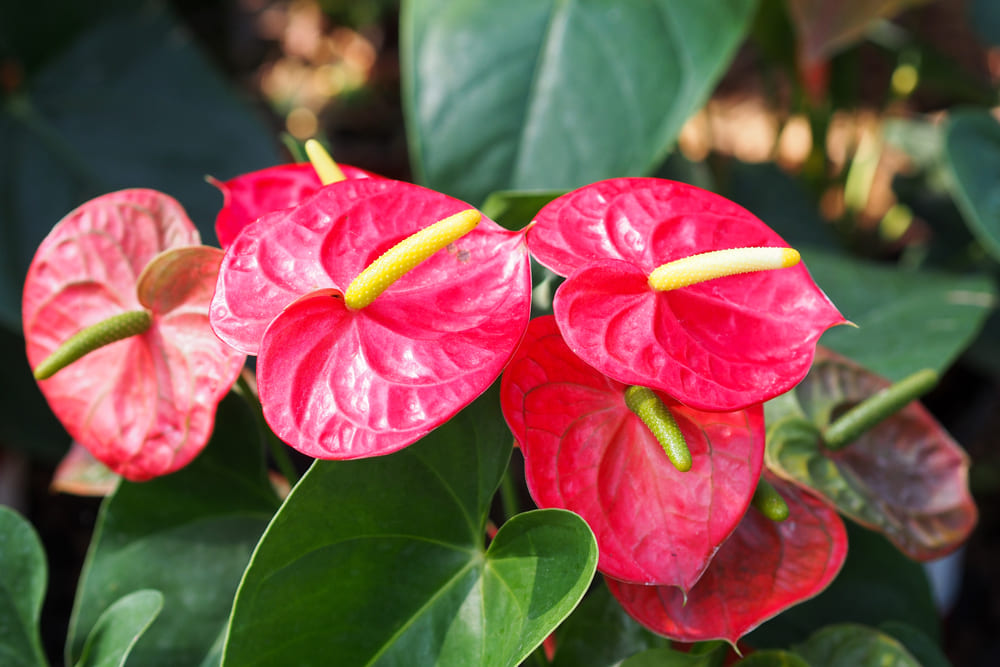
The Flamingo Flower (Anthurium scherzerianum) is a tropical plant that grows in rainforests of Central and South America. It has bright waxy red heart-shaped spathes and shiny dark green leaves. It can be easily grown indoors as a houseplant.
Its slender scape is a bit taller than its foliage. It is erect and has deep veins. Its white or red spathe may be flat, or tapered.
The sap within the Flamingo Flower is very toxic to humans and animals. The flavonoid sap is able to absorb harmful chemicals from the air, and its proteolytic enzymes produce histamines.
This type of tropical plant can be hard to care for. It grows best in a humid climate, but it can tolerate low temperatures. However, it should not be exposed to direct sunlight, as it can burn the leaves.
This plant is a great cut flower, and it has an exotic look. Anthuriums can be a long-term houseplant, but they should be planted in a larger pot than they will actually need.
You can keep your plant looking its best by following these simple tips. Watering should be done once or twice a week. The soil should never be completely dry.
2. Hibiscus

Hibiscus tropical flowers are beautiful, profusely-flowered shrubs. Typically, the blooms of a hardy type will be red or white, and the flowers of a tropical type will be orange or peach. These shrubs are mainly used in landscapes, and they grow well in areas with water.
Most people prefer to grow hibiscus in containers. This makes it easy to move them around. It’s important to choose a container that is large enough to hold enough potting mix. You may also want to add mulch to keep the ground cool and moist.
If you decide to use containers, you’ll need to water the hibiscus on a regular basis. The amount of water your hibiscus needs depends on the climate. Generally, you’ll need to provide one to two inches of water a week. It’s also a good idea to add a nutrient-rich fertilizer early in the spring. This will give your hibiscus a boost of nutrients for new growth.
It’s also a good idea to provide your hibiscus with afternoon shade to prevent sunscald. This is especially important if your hibiscus has been planted in a location where it will get direct sunlight all day long.
3. Amaryllis

The amaryllis is a perennial tropical plant that produces large blooms in a variety of colors. They can be grown indoors or outdoors. If you’re looking to add some color to your home, this easy to care for plant is a great choice.
The Amaryllis family has about 1600 different species. They originate from tropical areas of South America, Mexico, and the Caribbean. There are also several species that are cold tolerant and are suited for growing in zones 7 and 8.
Amaryllis bulbs are available in many varieties. These bulbs should be planted in a sunny, sheltered location that is well drained. It is important to keep the soil moist, but not wet. The weather and the type of soil will determine how much water you need.
Amaryllis can be purchased in bulb form, or in plant form. In the bulb form, you can buy your plants as seed pods, and then plant them in your garden or in a larger container. They can be dug out of the pot they’re in, or you can use a special container designed for growing amaryllis.
4. Bougainvillea Glabra
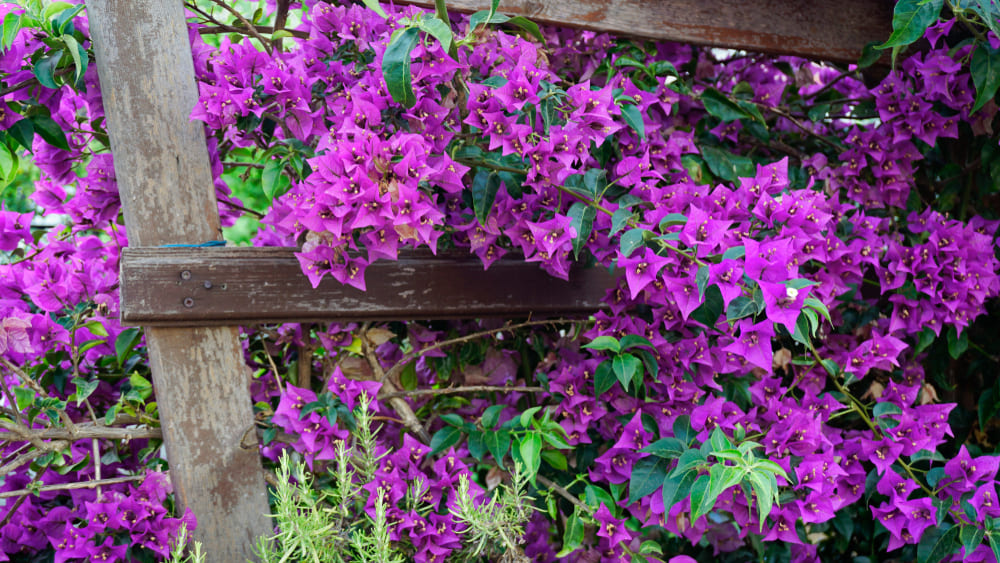
Bougainvillea glabra, commonly known as paper flower, is a climbing plant with tiny white flowers surrounded by colorful papery bracts. It’s a popular garden plant in warm climates. Its native habitat is in South America. It’s also used as a botanical insecticide.
This species is very easy to grow. It grows best in rich, well-drained soil. It is an excellent choice for pollinator gardens. It’s also an ideal bonsai plant. If you want to cultivate it, you’ll need to trellis it.
Its dark green leaves are glossy. The bracts of the flowers are wavy. They are also slightly hairy.
The plant can grow up to 30 feet tall. It’s often grown in pots. It’s best to keep it in a sunny area.
The plant is extremely heat and cold tolerant. It can grow in a variety of environments. It is commonly cultivated in tropical climates. The bloom cycle is shorter than the Great Bougainvillea. In colder areas, it blooms in the summer to autumn.
It is a semi-evergreen plant. Its stem is curved and woody. It’s a heavy feeder. It’s not susceptible to common garden pests.
5. Garden Cosmos or Mexican Aster
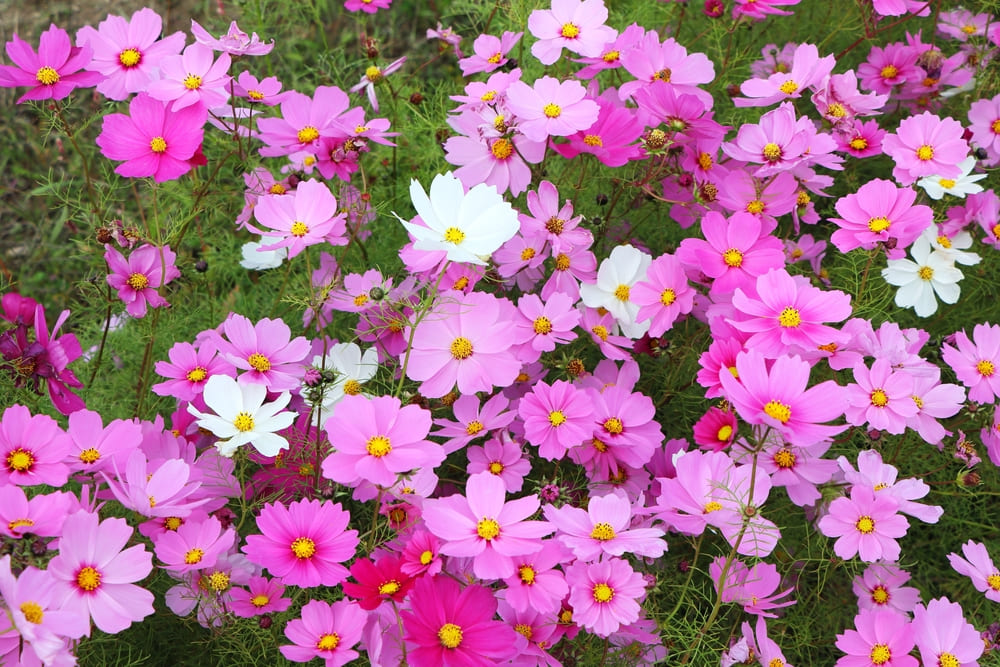
Cosmos is a tropical flower that grows in warm climates, including Mexico and South America. This easy-to-grow plant is known for its large, colorful blooms, and its ability to thrive in hot weather.
Cosmos is easy to grow from seed. Once planted, the plant produces a large amount of blooms that are great for cutting. It is ideal for containers and mixed borders.
Besides being easy to care for, Cosmos flowers are attractive to pollinators and beneficial insects. They are also long-lasting. They can be harvested when the flower is fully open, or dried for later use.
Cosmos is an ideal plant for gardens, cottages, and prairies. Because it requires little maintenance, it is a good choice for first time gardeners. It is especially beautiful in large groups.
Cosmos are also attractive to insects, such as birds, butterflies, and hoverflies. They are also attractive to parasitic mini-wasps, who prey on destructive insects. These are two important reasons why Cosmos is so popular.
Cosmos is a half-hardy annual that needs full sun exposure and an adequate amount of water. It also needs protection from wind.
6. Bush Lily
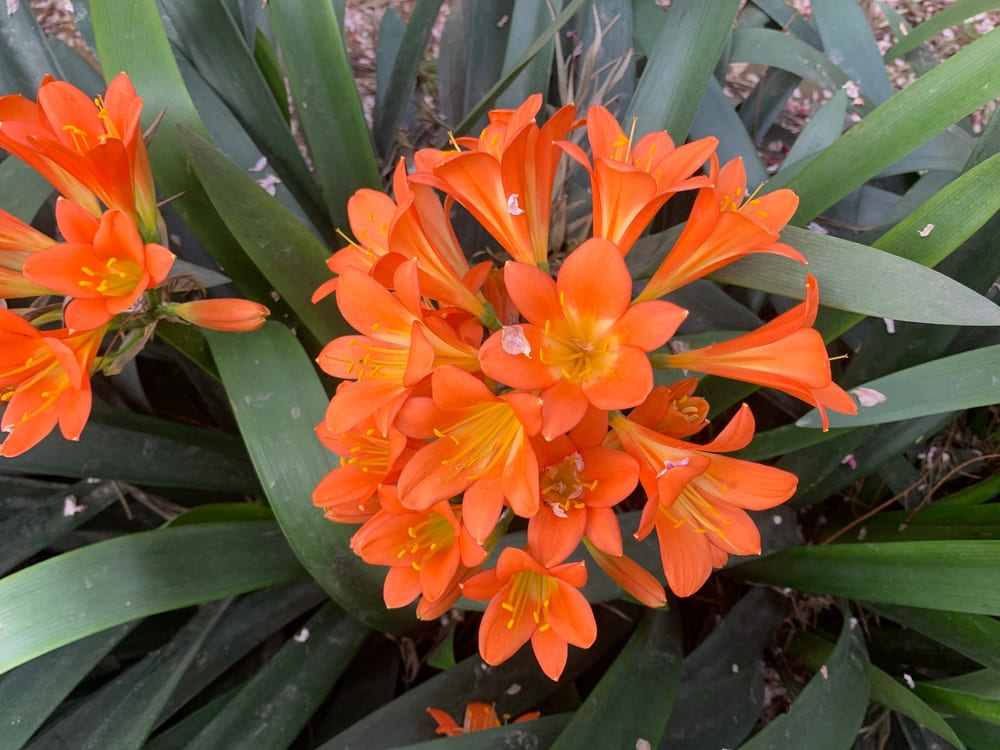
In Victorian times, the bush lily was a favorite plant for many gardeners. It is a perennial, flowering green plant that grows in dense clumps. It is best suited to woodlands and moist, rich soil. It is a great plant for both outdoor and indoor use.
A wide variety of tropical plants can be grown outdoors. These include Orchids, Tropical Milkweed, Bird of Paradise, Mexican Aster, and Paper Flowers. Several varieties of tropical flowers are also available as houseplants.
Fire lilies are hardy South African plants that make attractive houseplants. They are easy to grow. They can tolerate a dry climate but prefer partial shade. Its large blooms are often massed in drifts similar to daylilies.
The leaves of this plant vary in color. They can be red, orange, or pale yellow. They are also sometimes found in cherry-red colors. They can reach up to 6 feet high. The banana-shaped leaves attract hummingbirds.
Flame lilies are drought tolerant. They need to be in a shady spot with temperatures below 50 degrees Fahrenheit. They do well in containers. However, too much sun can kill the plant.
7. Blood Lily
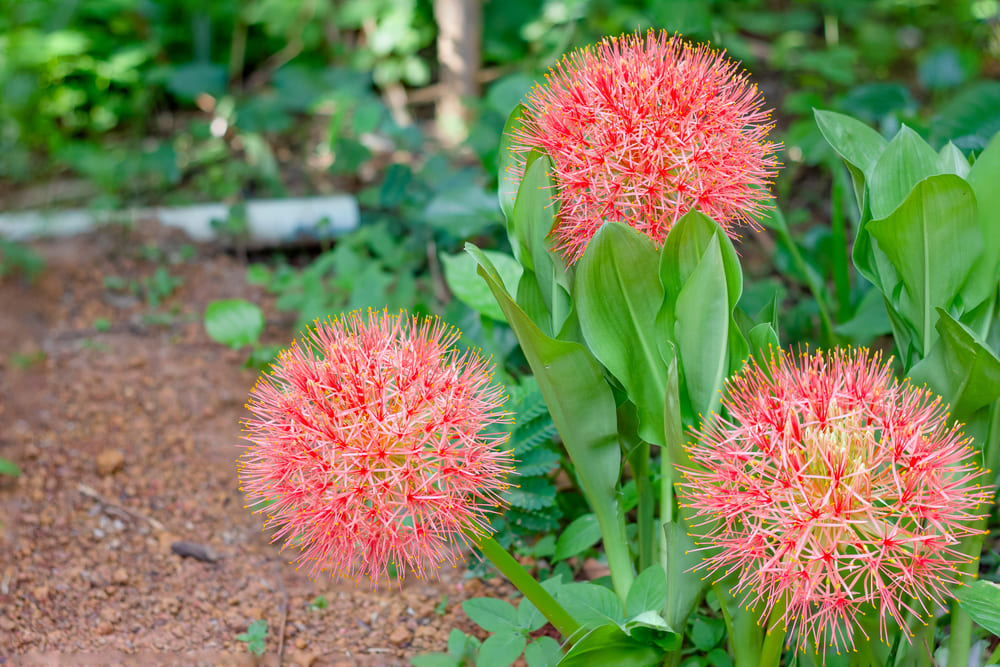
Blood Lily is a tropical flower that is native to Africa. It can grow in both lowlands and mountain slopes. It can also be grown as a houseplant. It is usually found in the shade of a large tree. It is a member of the Amaryllidaceae family.
Blood lily plants need a rich soil with good drainage. They can be grown in soil with high phosphorus content. The bulbs are also suitable for cultivation in USDA zone 9. If you are growing your blood lily as a houseplant, you may want to add a humidifier to increase the humidity.
The blood lily is an excellent addition to any garden, patio, or deck. This unique flower produces colorful red blooms. It also grows well in a container. It can be potted with rich potting soil and sand. This mixture is particularly good at retaining water.
Blood lilies should be watered frequently during the warm season. The plant should not be allowed to dry out. In spring, the plant can be watered again. However, during the winter season, blood lilies need special care.
8. Zingiber Neglectum Jewel Pagoda
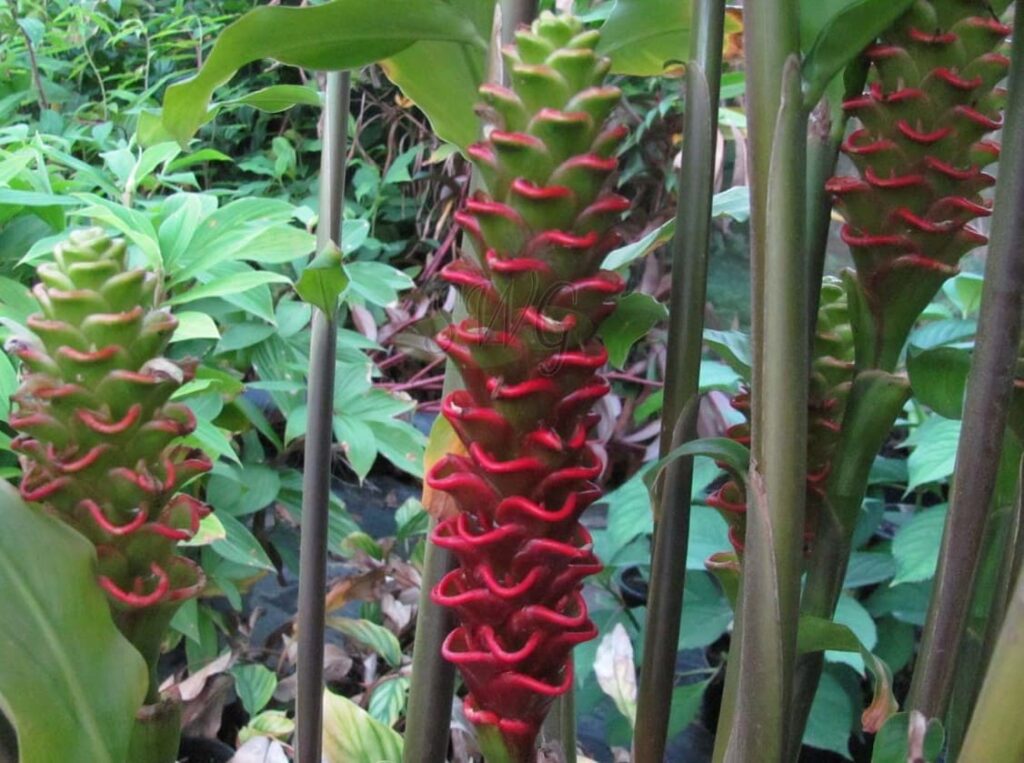
Tropical zingiber neglectum is an impressive container plant. The flowers are bright, and their scent is unique. The plants are hardy, and require little maintenance. They grow well in Florida. Some varieties can even be used to create ice cream cones. Tropical ginger’s flowers may even last for weeks.
Inflorescences look like sculptures. They can reach 12-20 inches high, and their bracts look a lot like pine cones. The flower’s true color is a pale yellow, with green bracts that turn red as the flower matures. They also have a waxy surface, which is attractive in its own right.
Zingiber neglectum is a perennial that grows well in part-shaded areas. Its name means “jewel pagoda,” and it looks just like that. It grows in moist, humus-rich soil, and is best planted in a partially shaded area. The flowers are shaped like a jeweled pagoda.
The best part about these flowers is that they are very easy to care for. They are also relatively inexpensive. The flowers are not very large, so they are not ideal for mass plantings. However, they are a wonderful contrast to other flowering plants in the garden. Their flowers can also last for weeks in the vase, and they are a valuable cut flower.
9. Ohe Naupaka
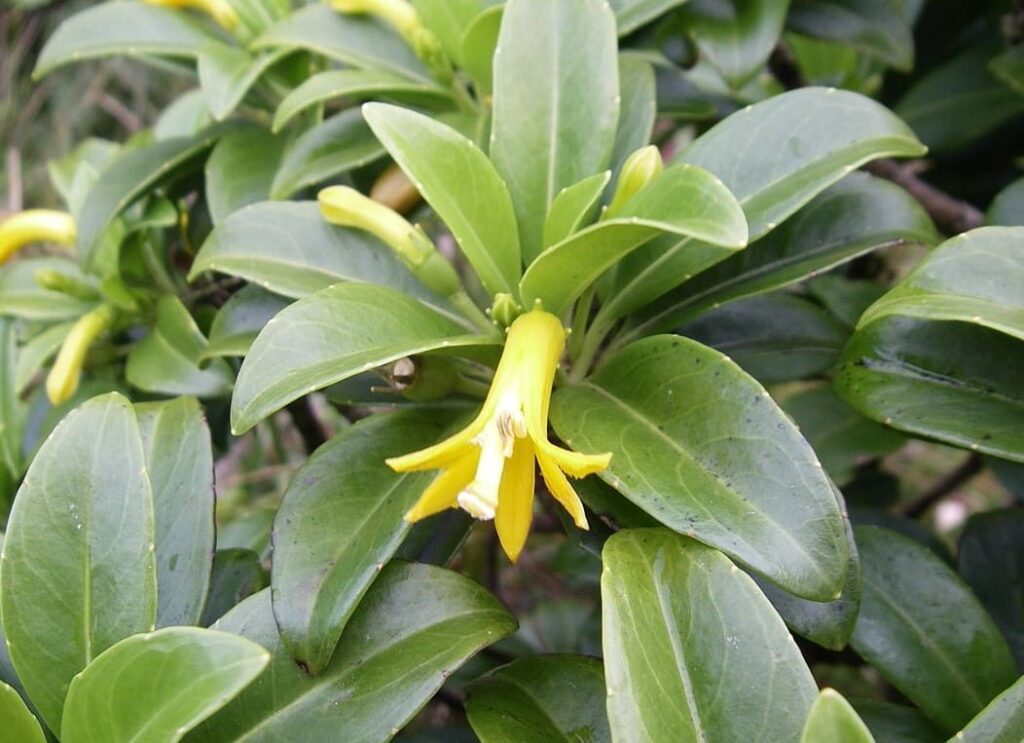
Naupaka is a plant native to Hawaii, and it is a shrubby flowering plant. It grows in mountainous and coastal environments. It has five petals, and the flower is often shaped like a fan.
Ohe ‘ohe, a tropical flower, is endemic to Kauai and Oahu. It is one of the only two types of naupaka found in Hawaii. The other is ‘ahinahina ‘, or the silver geranium. It is also a member of the jasmine family. The ‘ahinahina has soft rounded leaves.
The flower has a white or yellowish hue. The ‘ahinahina’ can grow to six feet tall. It flowers throughout the year. It should be fertilized once every six months. It thrives in hot, dry weather.
Beach naupaka has a distinctive light green foliage. It grows in sandy beaches, and it is adaptable to the coastal environment. It is able to tolerate salt spray from the ocean. It has a dense mound of foliage that can grow to six or seven feet. Its berries are bright purple and attract birds.
The Hawaiian legend tells the story of Princess Naupaka and her lover. The lovebirds traveled to a remote temple, but the priest told them he could not help them. He told them they would have to go back to the beach.
10. Hawaiian Hibiscus or Chinese Hibiscus
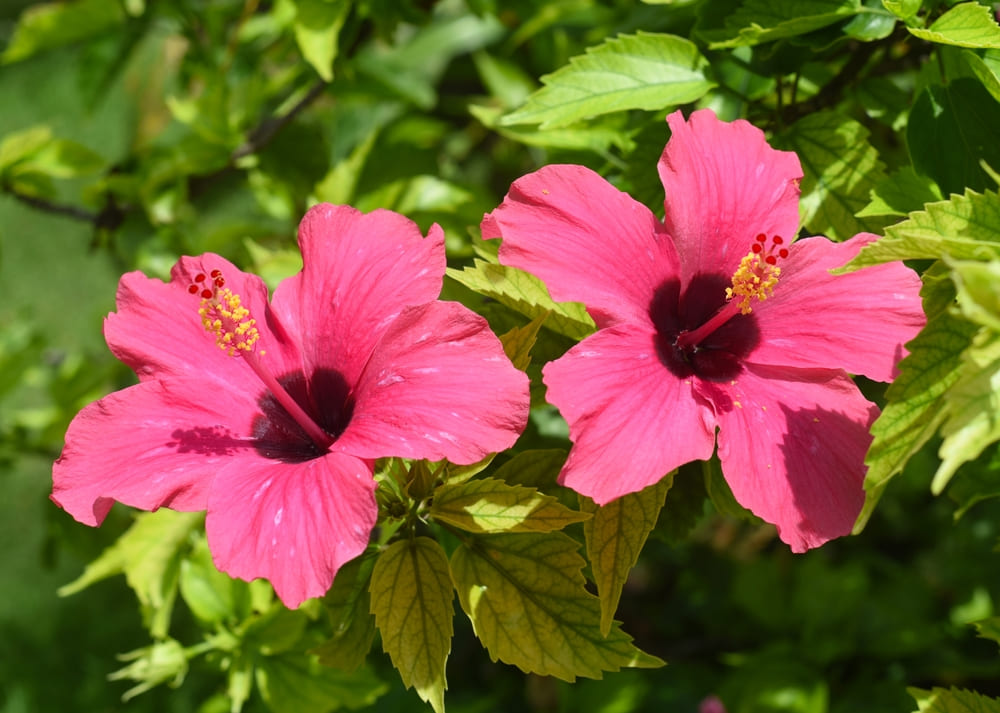
If you are looking to create a tropical feel in your garden, you may want to consider growing Hawaiian Hibiscus or Chinese Hibiscus. These are two types of tropical flowers, each with their own unique attributes.
These tropical plants have a tendency to produce large bold blooms. They can be grown in the yard as annuals, or planted in containers as perennials. To grow these types of tropical plants, they require a warm environment with a lot of sunlight and adequate moisture.
When you are ready to plant, you should start the seeds about ten to fourteen weeks before the last frost date for your area. Once the danger of frost has passed, you can transplant the plants into a larger container.
If you live in a warm climate, you can also grow these plants as indoor houseplants. They will need to be kept away from cold drafts and placed in a warm room with a good heating system.
You should give your hibiscus a water-soluble fertilizer. This is the easiest way to keep the plant healthy and growing. The plants will need regular watering throughout the spring, summer, and fall. However, during the winter months, you can reduce the watering.
11. Bird of Paradise

If you’ve ever seen a bird of paradise, you’ve probably admired its dazzling color and intricate structure. As a result, you may want to grow this plant at home.
The birds-of-paradise is a family of plants with more than 40 species in 17 genera. Most species are found in eastern Australia, Papua New Guinea, and southern Africa. Some species are threatened by hunting and habitat degradation. These plants are hardy and easy to care for, and can be kept to manageable houseplant size.
The most common species produces an orange and blue flower. This tropical plant can be grown in warm climates.
Bird of Paradise is closely related to the banana plant. Its name comes from its brightly colored flower. This beautiful plant is often used by florists as a centerpiece in exotic arrangements.
The bird-of-paradise has been used as a symbol of love, faithfulness, and good perspective. It is also known as the Crane Flower. This plant is native to the subtropical coastal areas of southern Africa. It is now naturalized in many parts of the world, including Central America, South America, and Hawaii.
12. Sacred Lotus
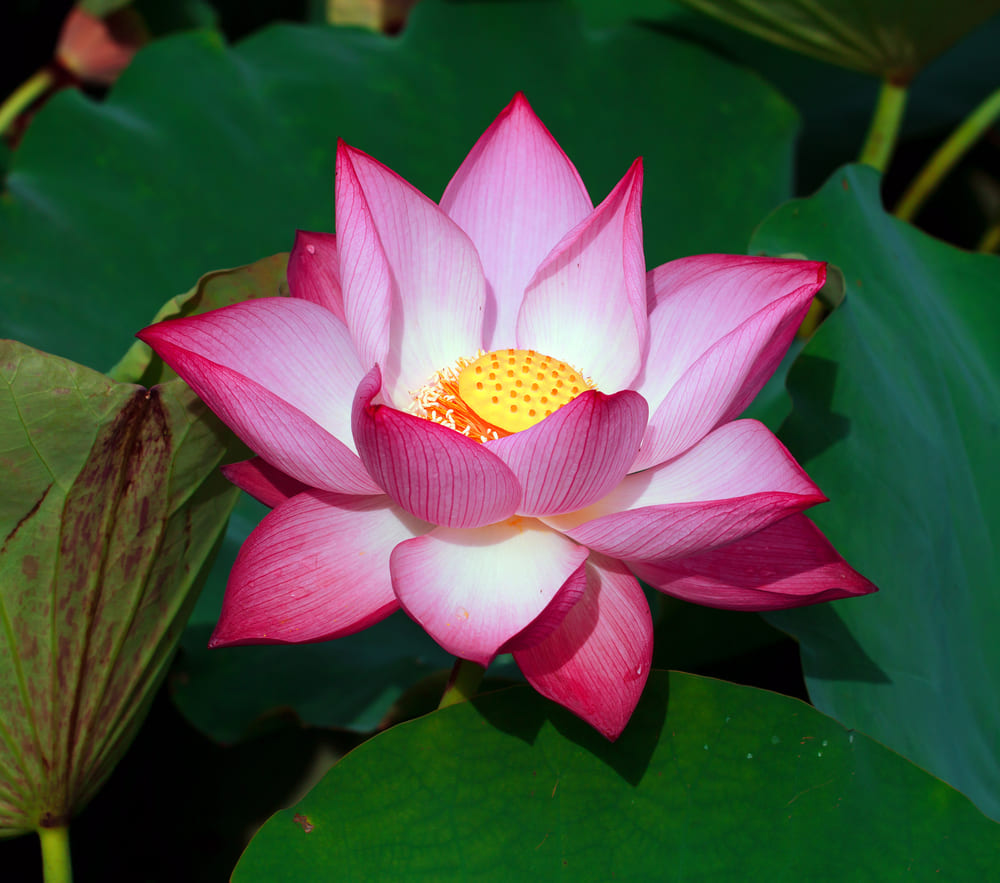
The sacred lotus is a flowering perennial aquatic plant of the Nelumbo family. This plant is widely used as a folk medicine. Historically, it has been used for traditional Chinese and Ayurvedic medicine. However, it also has a variety of other uses. It has been reported to act as an anti-aging agent.
The sacred lotus is native to tropical Asia. It is widely cultivated in East Asia, where it is used as a source of food. Its rhizomes are also used as vegetables. The seeds are highly nutritious. Those that have been harvested are processed into different foods.
The roots of the sacred lotus contain thick fibrous rhizomes. These roots have been shown to have inhibitory activities against a key enzyme. This enzyme is beta-secretase. The extracts of the rhizomes have been found to increase dopaminergic neurotransmission. It was also found to inhibit AChE.
Interestingly, the sacred lotus has been reported to affect Alzheimer’s disease. This is due to its antioxidant properties. The antioxidant activity of the sacred lotus was measured by FRAP assay and DPPH radical scavenging assay.
13. False Bird of Paradise or Hanging Lobster Claw

The False Bird of Paradise or Hanging Lobster Claw is a type of plant commonly found in Florida. It is a fast growing, invasive plant that produces bright, colorful flowers. It can be a decorative plant or a landscaping plant.
The Hanging Lobster Claw is native to Central America and is grown in both tropical and temperate climates. It can grow to 15 feet tall in the right setting. In the right place it can create a tropical look and feel to any landscape.
The most important thing to remember when caring for the False Bird of Paradise is to keep its leaves clean. This will increase the plants’ photosynthesis efficiency and help keep the plant looking neat.
There are many varieties of the plant available. Those that prefer partial sun will produce more flowers. Some of the newest varieties are also drought tolerant. You can also protect your plant by installing root barriers.
Heliconia rostrata is a perennial herb in the family Heliconiaceae. It is a large ornamental plant with leathery banana-like leaves. In its natural habitat, it is a native of Amazonia, Bolivia, and Peru. It is a popular choice for flower arrangements.
14. Scarlet Sage
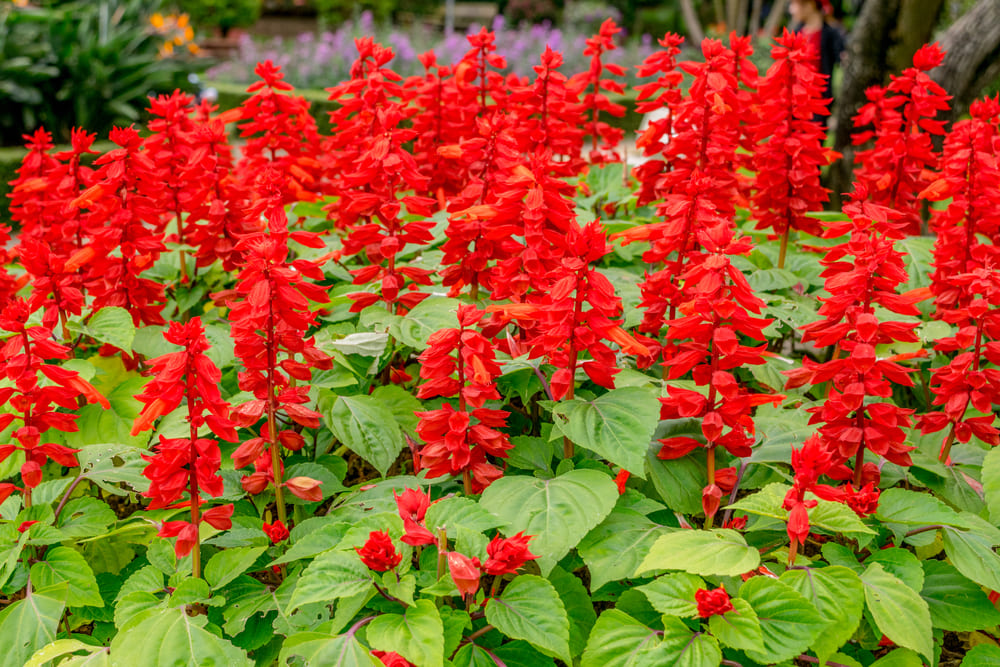
The tropical flowers of scarlet sage are a beautiful addition to your garden. They attract butterflies and other pollinators. They are a great option for hummingbirds. They are easy to grow. You can plant them in containers or in the ground.
This species is native to the Southeastern United States, as well as northern South America. It is a member of the Lamiaceae family.
This herbaceous perennial has oval leaves. They are dark green and up to three inches in length. They have an odor that deters mammals.
Scarlet sage grows well in moist, but not wet soil. It has a good tolerance for drought. It will reseed frequently. It also grows well in sandy soils. The plant is best planted in full sun or partial shade. It can be grown as a border plant, and as an ornamental plant for cut flower gardens.
It is important to note that overwatering can lead to root rot, mildew, and mold. It is also a good idea to avoid overhead watering.
You can grow tropical sage as a container plant or as a border plant. The plants can grow up to 2 feet wide and up to 4 feet tall.
15. Star Flower or Egyptian Star Cluster
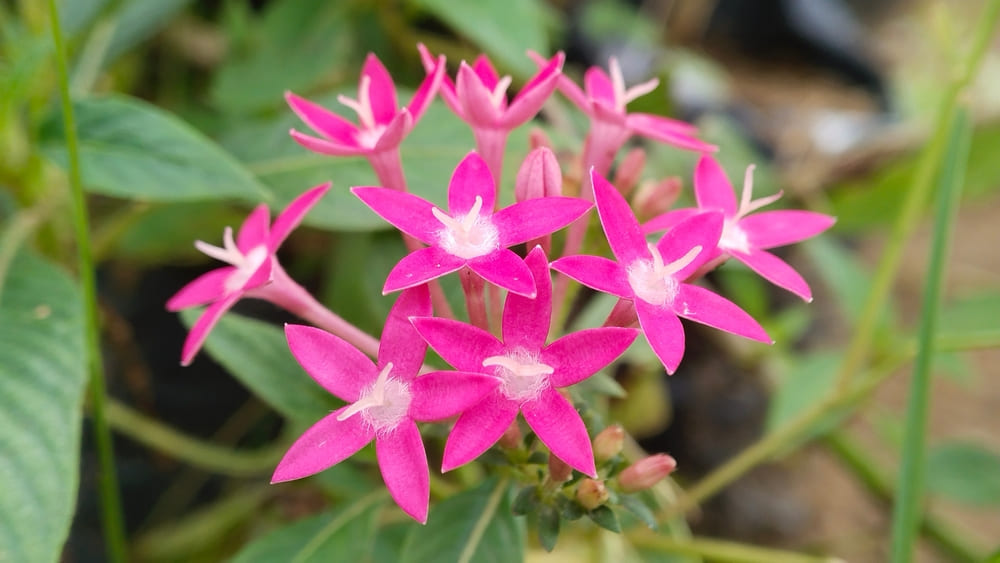
The Egyptian Starcluster is a tropical woody-based perennial plant. It features elliptic to lanceolate dark green leaves with clearly visible veins. It also has a rounded cluster of star-shaped flowers that attract butterflies. The Star Flower is also a popular ornamental flower for gardeners.
The Pentas lanceolata, or Egyptian Starcluster, is a semi-tropical perennial that is usually grown as a houseplant. It is not suitable for growing in direct sunlight or near heat sources such as air conditioning units.
The Egyptian Starcluster is a great plant to grow indoors as it is hardy enough to withstand a lack of water. However, if your goal is to keep it alive for long, you will need to water regularly. In addition to regular watering, you will need to make sure that the plants have adequate drainage.
You will also need to give it the appropriate fertilizer. The proper amount is dependent on the size of your plant. During the first couple of years, your Egyptian Starcluster will put most of its energy into producing new roots. Once it matures, it will require less maintenance.
16. King Protea
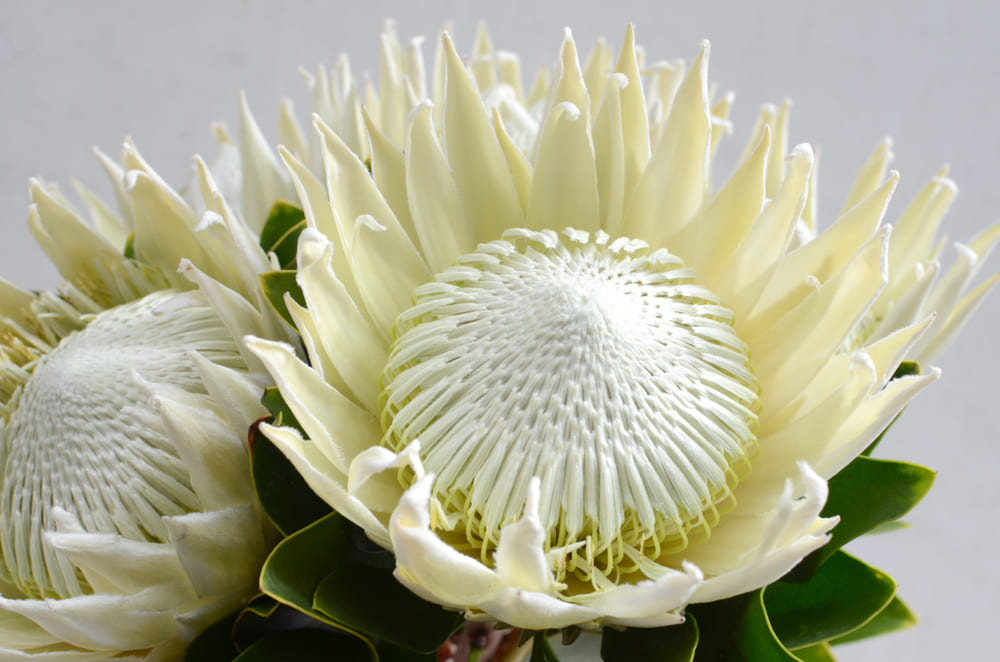
King Protea is a flowering shrub that makes an impressive addition to a garden. The flowers have a stunning appearance that is admired by both gardeners and florists alike.
Proteas are a family of plants that have been around for hundreds of millions of years. They are able to take in moisture through their leaves and grow well in coastal areas. However, they do need a warm climate, with temperatures between 28 and 40 degrees Fahrenheit. They are also prone to frost, so they need to be protected during winter months.
Proteas have an unusual shape, with their petals curling inward toward a fuzzy core. They come in a range of colors, including pink, red, and orange. They make an ideal focal point in any arrangement.
The king protea is native to South Africa. It grows on the Cape of Good Hope. The stems are thick and woody. They can be up to three feet tall. They are not very resistant to pests and can be easily destroyed by wildfires.
The king protea can be grown in various environments. They are tolerant of harsh weather, but they do not do well in clay-like soil. They prefer well-drained soil. They need a lot of sunlight and air circulation. They should be pruned after they start to bloom.
17. Chenille Plant
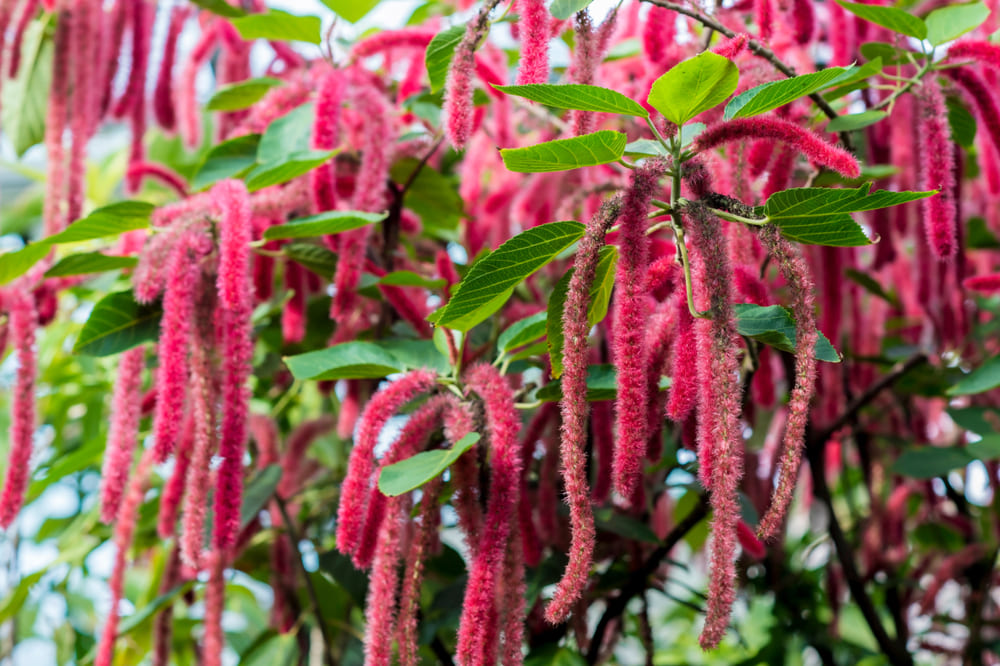
If you are looking for a tropical flowering plant, the chenille plant can be an excellent choice. This plant can be grown both indoors and outdoors. However, it does require a lot of warmth and moisture to thrive. It can also be difficult to grow in a container. So, you might want to consider starting it from a cutting.
This tropical flowering shrub is native to parts of Asia, New Guinea and the southwestern Pacific. It can be a hardy plant, especially in frost-free zones. It produces long, drooping catkins and fuzzy tails. They come in many colors, including pink, yellow and gold.
The chenille plant grows well in the sun, but it needs to be protected from freezing temperatures. It can be used as an annual in cooler climates, but if it is planted in landscape, it should be watered daily.
Chenille plants are known for their bright red flower spikes. The plant grows in various soils, but it prefers moist and well-drained conditions. It will tolerate a range of pH values.
Chenille plant flowers are a great addition to a shrub border or flower bed. They can be used with other fine textures to create a striking contrast. They are available in several different colors, including pink, white, gold, and red.
18. Indian Shot

Indian Shot tropical flowers are a beautiful and decorative plant. They are commonly grown indoors in temperate regions. They produce vibrant and colorful flowers in late spring and autumn. They can be planted in flower beds, in pots, or in containers.
Cannas are part of a genus of ten species in the Cannaceae family. They are genetically more similar to bananas than to lilies. They grow naturally in the tropics and can also be grown from seeds.
The name “Indian shot” comes from the black seed that the plant produces. This plant has been used as ammunition and as a musical instrument. They are also cultivated as a minor food crop. In addition, their seeds can be strung into leis, hula rattles, and even beads for jewelry.
The plant is native to South and Central America and the Caribbean. It grows to a height of 1.5 m.
It is a perennial and has a drought-tolerant nature. It is easily grown from seed or tubers. It is a good plant to have in the garden for its thornless leaves and its striking flowers. The rhizomes are edible, and they can be used in cooking.
It is important to keep a close eye on the roots, as overwatering can result in root rot. It is best to water sparingly during the active growing season and to make sure that the first few inches of soil are dry before watering again.
19. Christmas Cactus

Christmas Cactus tropical flowers add a splash of color and holiday cheer to your home. It is a common houseplant that is easy to care for. The best way to make sure your plant remains healthy is to follow a few simple steps.
First, be sure to place the Christmas cactus in a location that provides indirect light. If it does not receive sufficient light, the plant will probably not bloom.
The best soil for Christmas cactus is a well-drained soil that has a high percentage of organic matter. To keep the soil from becoming dry, water every week and a half during the winter. During the growing season, it may need to be watered more often.
The Christmas cactus needs to be treated differently than a desert cactus. When it is in the bloom stage, it does not need fertilizer. However, after it has bloomed, it will need more moisture than a desert cactus.
It is also important to protect the plant from root mealybugs, which can destroy the plant’s roots. This type of pest is not resistant to fungicides. For this reason, it is recommended to discard any infested plants.
Although the holiday cactus does not require the same care as a desert cactus, it is important to monitor the temperature and humidity. The holiday cactus will require watering once or twice a week in the winter.
20. Persian Cyclamen

Persian Cyclamen tropical flowers are very popular with florists. Cyclamen persicum is a species of tuberous plants native to the eastern Mediterranean. It grows in the wild in Tunisia, Algeria, and Iran.
Persian cyclamen is a plant that can grow outdoors or indoors. It can be found in florists and garden centers.
It is a warm-climate plant, but it can be damaged by too much water. It can also become brittle and prone to mold and mildew. If you plan to buy a cyclamen, make sure you are buying one that is already blooming.
It is best to avoid overwatering a Persian cyclamen. It can shock the plant and cause root rot. If your cyclamen is not getting enough water, it can also become swollen and brittle. If you want to keep your cyclamen alive, you should give it a few months of rest.
Once the cyclamen is blooming, you may need to water it more frequently. It is best to water it from the bottom. If you are not able to water it by hand, you can place it in a container filled with lukewarm water for a couple of hours.
After the flowering period, the cyclamen will go dormant. You can begin to water the plant again after two months of dormancy.
21. Damask Rose
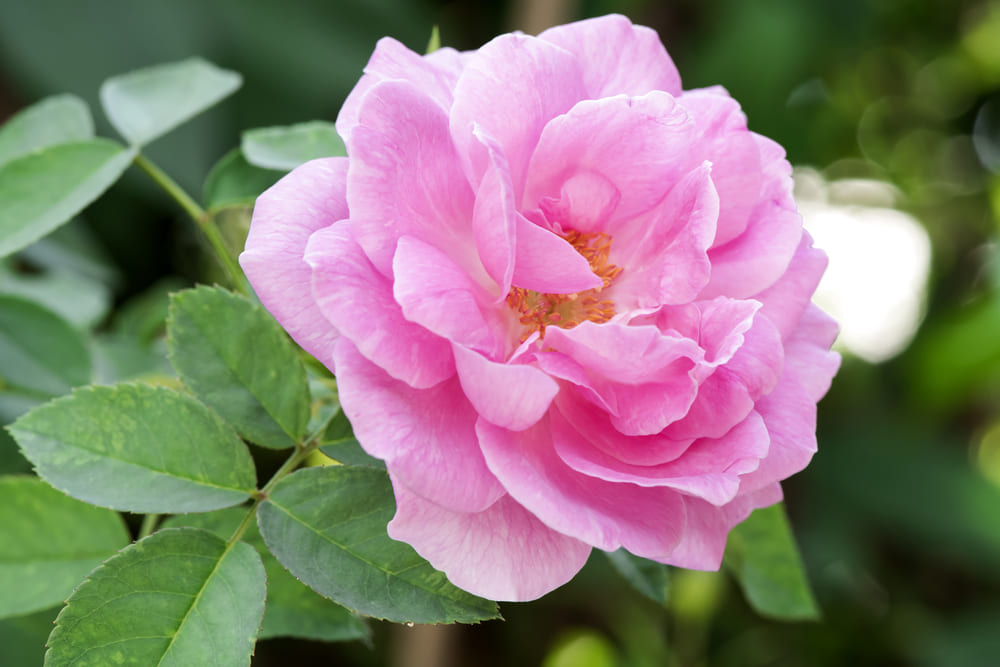
Damask rose, also called as the Turkish rose, is a rose species that has been around for centuries. The first mention of it was by Herodotus, a Greek historian, who recorded the cultivation of the rose by the Phrygian King Midas in Anatolia. The Greeks and the Romans valued the rose for its fragrance.
The Damask rose can be found in different climates, but it does best in humid and subtropical areas. It prefers a moderate climate and can grow well in a moist, but slightly acidic soil. In the spring, it provides a profusion of pink flowers. The fruits are red and pulpy. They are rich in vitamin C.
The Damask rose is a perennial plant that has a lifespan of about 20 to 30 years. However, the life of a bush can be extended to 50 years if it is properly cared for. Its fruit is rich in vitamin C and has a hint of grapefruit flavor.
The rose can be used in teas and jams. Its oil is useful in cosmetics and perfumery. It contains terpenes and polyphenols.
The flowers of the Damask rose have been harvested for their essential oil for centuries. The petals are often striped, with a two-toned appearance.
22. Wild Lantana
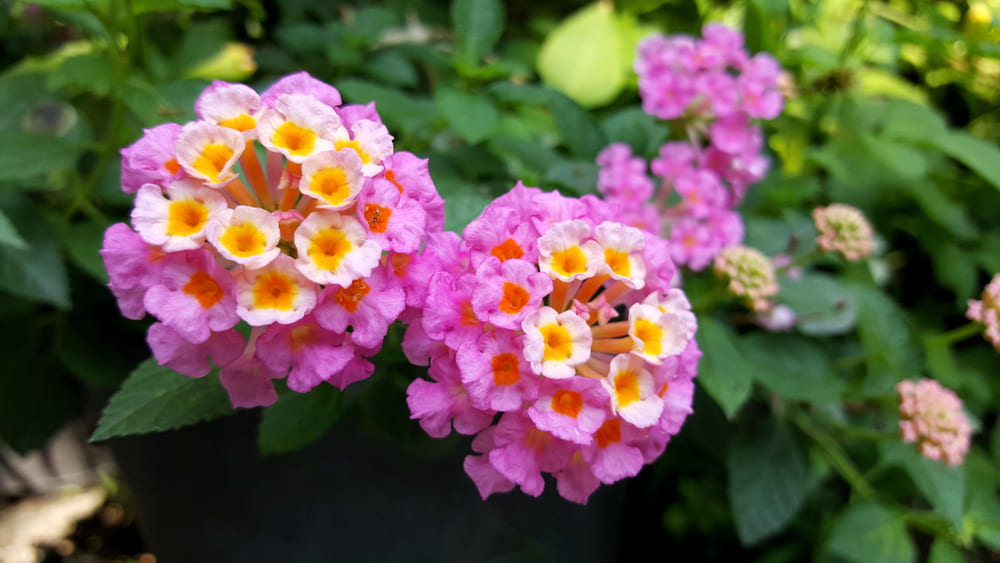
If you’re thinking of adding a tropical flowering shrub to your garden, consider Lantana. These easy to grow plants are popular in both hanging baskets and ground covers. They require little care and only need light feeding in the spring. They can survive most pests.
There are many varieties of Lantanas. You can choose from varieties that bloom in shades of yellow, purple, red, orange, or blue. A single plant may grow to three feet tall.
These shrubs thrive in full sun, although they can also tolerate partial shade. They prefer soil that is well-draining and slightly acidic. They will need regular watering and don’t need a lot of fertilizer.
When planting, you should dig a hole that’s large enough for the root ball. Then, backfill with a good potting mix and a layer of mulch. You can use gravel or coarse organic matter to help retain moisture.
In winter, keep your Lantana indoors or in a greenhouse. They will not bloom during the cold months. However, you can expect to see them begin to bloom in the fall.
There are several types of Lantanas, and each has its own unique characteristics. Some are drought tolerant, and some are cold tolerant.
23. Florist’s Daisy

The Florist’s Daisy is a beautiful perennial plant that is known to be useful as a houseplant. Its rolled petals and thick leaves create a beautiful bloom that can be enjoyed inside or outdoors.
This species is usually planted in gardens. This variety can be purchased from local nurseries and online. You can also send a bouquet of this plant as a gift.
The flower can last for several weeks. In addition, it has medicinal properties that can help alleviate anxiety and eye inflammation. It can also neutralize toxins and blemishes on the skin.
It has been widely cultivated for centuries. In the nineteenth century, this plant was very common in Europe. This particular variety is a hybrid of two species: Chrysanthemum indicum and Chrysanthemum japonicum.
The florist’s daisy is a beautiful plant that has been used for centuries as a garden plant. It has unique air filtering properties that can help to keep indoor spaces clean. It is also an easy-to-care-for plant. It can be found in many colors and can be a lovely addition to any garden.
24. Bromeliads

Bromeliads are exotic flowers that add a bright splash of color to a room. They are typically grown as houseplants, but they can also be placed in landscaping. They can thrive in tropical climates. However, they require proper care to maintain their healthy growth.
Depending on the type of bromeliad you are growing, you may need to change your watering techniques or adjust your light exposure. Some varieties are especially prone to root rot if the soil stays wet. If you have trouble keeping the soil dry, try a combination of organic material and drainage stones to keep the soil clean.
The optimal temperature range for bromeliads is 70-90oF. However, some species can handle days over 100oF.
When you are ready to move your bromeliad, you will need to ensure that the root system is well established. Bromeliads have long roots that serve as an anchorage and as a means of absorbing water. When you transfer your plant from indoors to outdoors, you should first lift it from the pot. Then, you should place it in a shady spot.
25. Tropical Milkweed
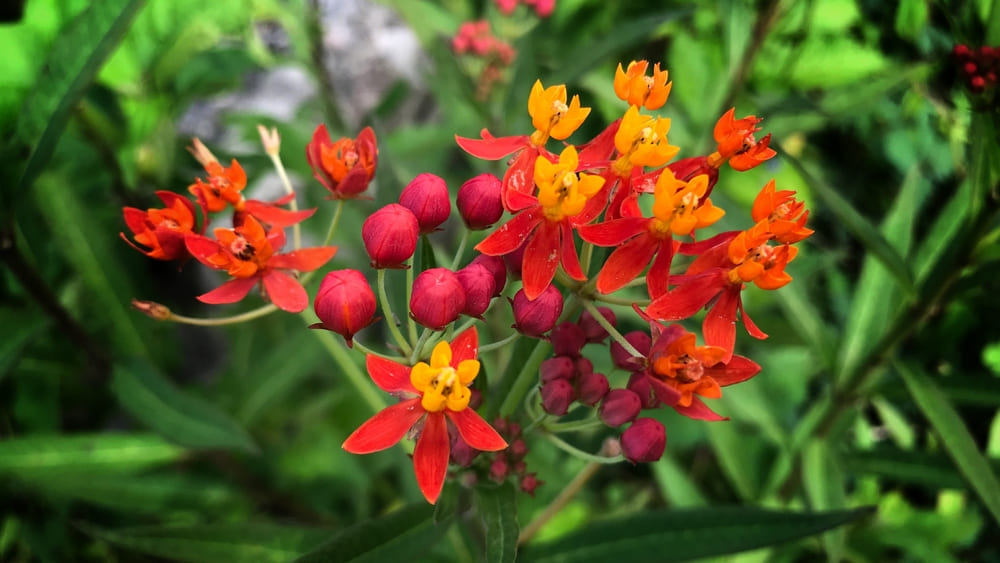
Tropical milkweed is a plant that isn’t native to the United States. It’s also a parasite that has the potential to harm the Monarch butterfly. While it can be beneficial to the monarch, it can also confuse them into breeding and not migrating. Despite this, tropical milkweed has exploded in popularity.
Tropical milkweed is native to Central and South America. In Mexico, it grows naturally. In the United States, it grows in Texas and Florida. It also grows in the Caribbean.
It’s a relatively easy plant to grow, and it has many uses. It produces flowers that are attractive to humans and many species of butterflies. It also attracts hummingbirds.
There are several varieties of milkweed that have become more available to the nursery trade in recent years. Some are available as potted plants that can be overwintered indoors. Some are sold as annuals. You can propagate tropical milkweed yourself with your own pollen, or buy it in a garden store. It grows two to four feet tall and has a deep taproot.
26. Barberton Daisy
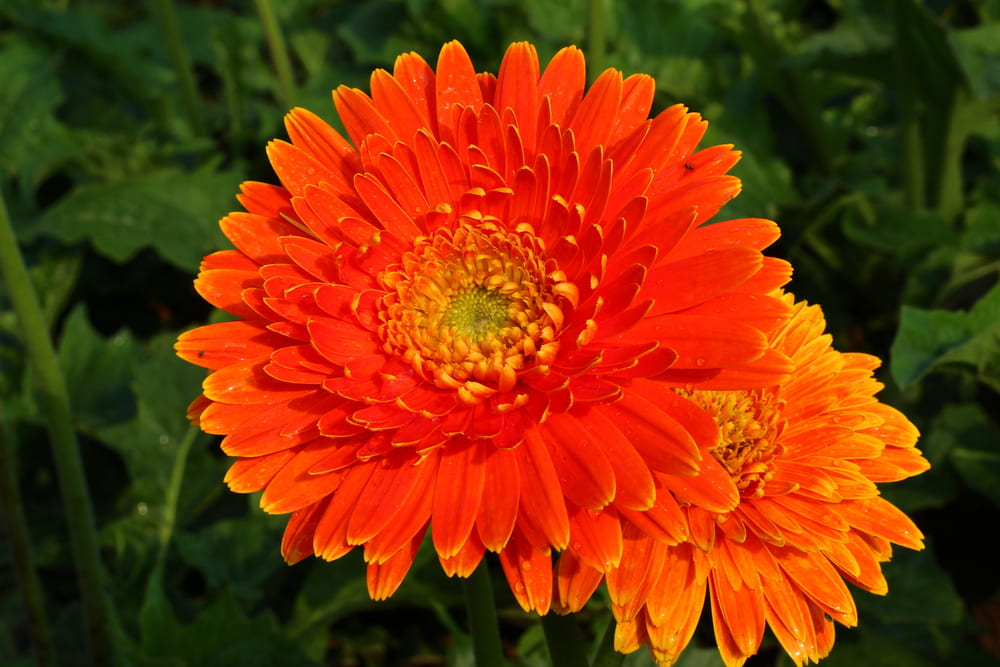
If you’re looking for a colorful flower to add to your garden, then consider planting the Barberton Daisy. This flower is a tropical plant that can thrive in a wide range of climates. It’s easy to grow and has bright and beautiful flowers.
The Barberton Daisy is a popular plant that is available in a variety of colors, including pink, red and orangish. It also can be grown indoors or outside in the ground.
The Barberton Daisy has multi-petal flowers that are connected in a round shape. The plant is also very fragrant. It has excellent foliage, making it a perfect addition to any garden. It can grow in zones 10+ as a perennial.
If you’re considering planting a Barberton Daisy, it’s important to understand how it grows. You’ll need to water it properly to ensure its health. This plant will need a lot of moisture during the growing season, especially in the first few years. It is also a good idea to test your soil before you begin planting.
27. African Violet
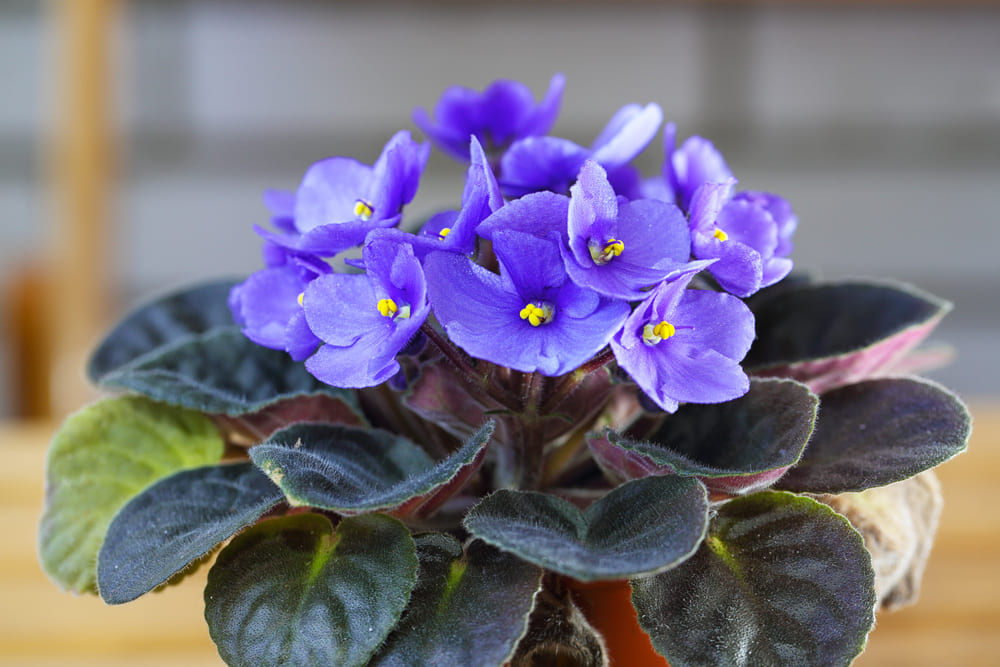
African Violet is a tropical flower that is grown in the forests of Kenya and Tanzania. Although it is a flowering plant, it can be difficult to care for. The best way to keep it healthy and happy is to follow some basic tips and tricks.
First, make sure you have a proper pot. The ideal African Violet pot is one that is at least 3 inches wide and two thirds the length of the plant’s foliage. This ensures that the plant will have plenty of room for its roots to grow and also allow it to get the proper moisture.
Next, ensure your African Violet has ample light. This means the plant should be placed in a room with sufficient ambient lighting. It should get 10-12 hours of bright light a day. The plant’s blooms will not last long if it isn’t getting enough light.
If you don’t have a room with plenty of natural light, then you can buy a grow lamp to give your plants the best possible lighting. It’s best to find a grow light that can offer a lux count of at least 10k.
28. Showy Medinilla or Rose Grape
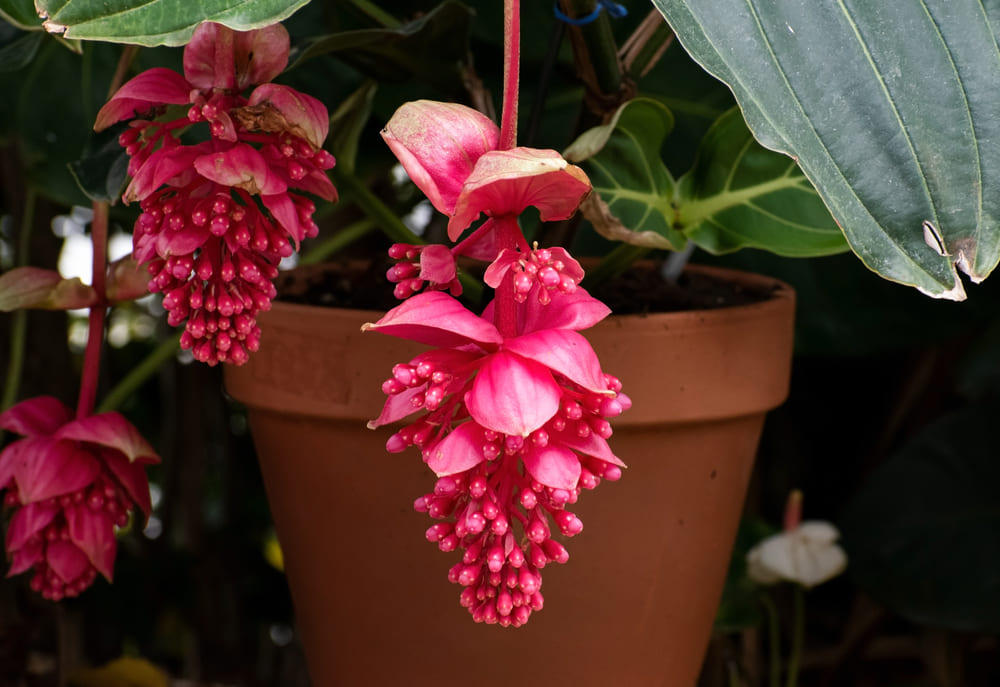
Showy Medinilla is an evergreen tropical plant that is often grown in the home as a houseplant. Its leaves are 30 cm long and deeply veined, making it an attractive foliage plant. It also features beautiful pink flower clusters that are up to 3 m high.
Growing Showy Medinilla indoors can be challenging. It has strict temperature requirements during early summer.
When growing the plant indoors, you should ensure the humidity level around the plants is high. You can achieve this by using a humidifier. The plant can also be placed in a greenhouse.
You can also propagate the plant from cuttings. You should choose the right type of cuttings to plant. These cuttings should be at least two leaves and at least three inches long.
You can also grow the plant in hanging baskets and pedestals. The rose grape is a hardy plant, but it can be difficult to keep alive if the climate is too humid. It only needs to be re-potted every few years.
You can propagate Showy Medinilla from seeds. The seed can be harvested when the fruit is fully ripe.
29. Peace Lily

The Peace Lily is a popular houseplant and is a great way to brighten up any room. This plant is ideal for indoor decoration because it is relatively easy to care for. It also purifies the air. Its leaves are paddle-shaped and can grow as high as six feet.
The peace lily is a tropical flower that grows naturally in the undergrowth of tropical rainforests. This plant can be purchased as a seedling, but it will probably not be fully mature until it is at least a year old. The good news is that you can easily propagate new plants from your own seeds.
If you have the right environment, this tropical flower can thrive. The best places to plant it are in well-draining soil. It should be kept in indirect light to encourage the flowers to blossom. It is not a demanding plant, but it does require regular watering.
If you are new to the Peace Lily, the best place to start is in a container. Make sure it has good drainage holes and is at least two inches bigger than the roots of your plant.
30. Common Jasmine
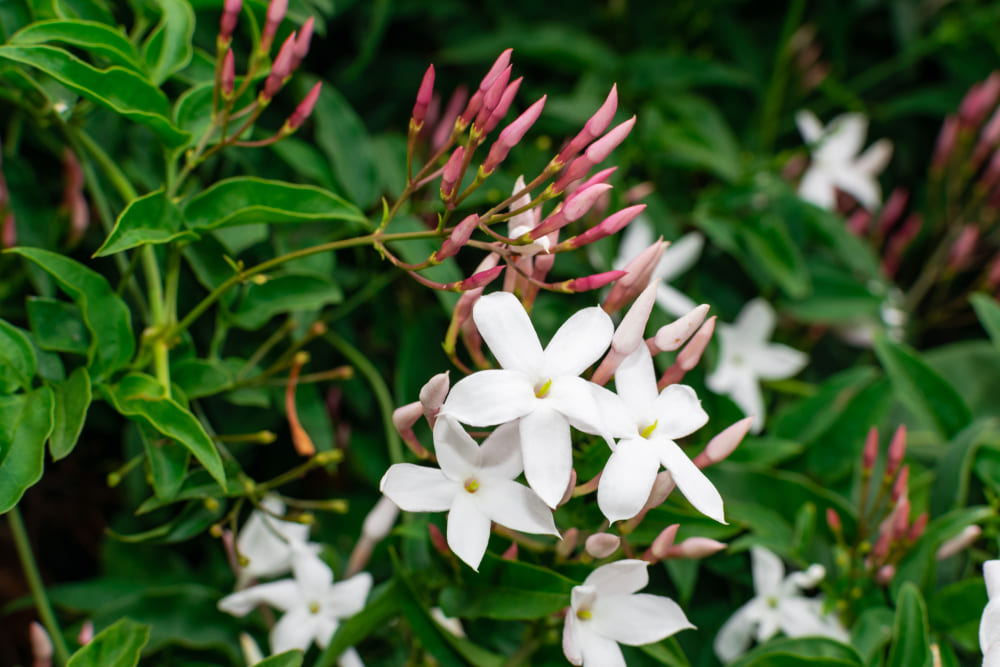
Jasmine is a tropical flower that can be used to produce fragrance. It is also an ornamental shrub that can be planted in landscapes and in pots. There are many different varieties of Jasmine. They all require different care. Some varieties are hardy, but others are not.
In order to grow jasmine successfully, you will need to find a cultivar that is appropriate for your climate zone. You should also fertilize your plant regularly. The best time to do this is in the spring. If you want to propagate your plants, you can use cuttings.
If you decide to plant jasmine in a container, you’ll need to keep the plant moist. It will need multiple waterings per week. A mulch or compost can be added to the soil. If you choose to put your jasmine into a greenhouse, you should ensure that it gets enough sunlight. The temperature should be 60 to 75 degrees Fahrenheit.
Jasmine can be hardy and easy to maintain. However, it does need a lot of sun, and it will not survive if temperatures are too cold.
31. Angel’s Trumpet
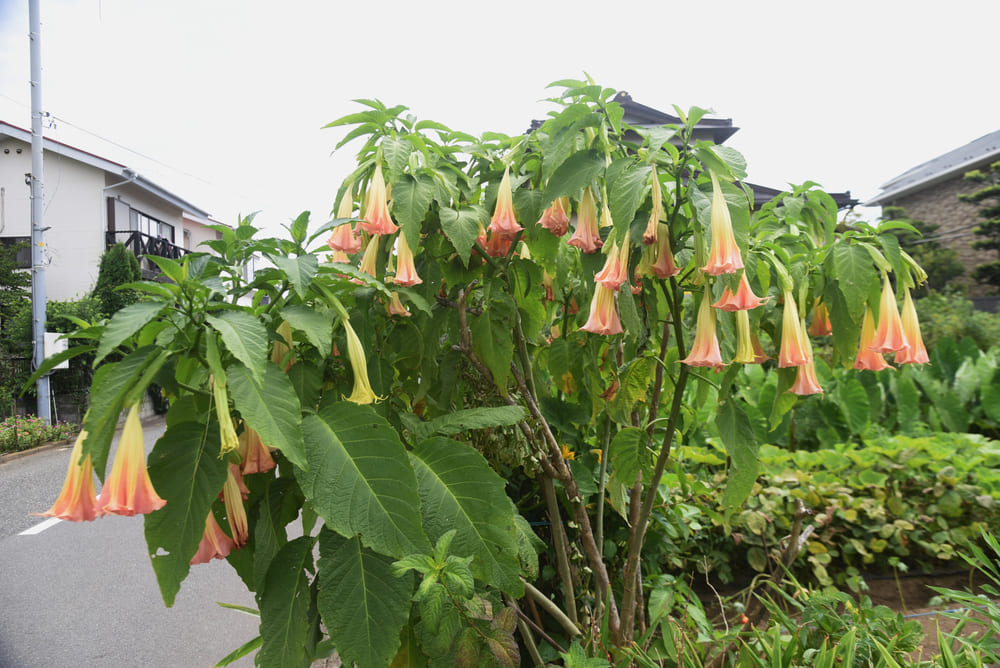
Angel’s Trumpet is an evergreen shrub or tree that is also an exotic tropical flower. It is native to the Andes of South America. It is found from Colombia to Ecuador. It can be cultivated in containers or in the ground.
An Angel’s Trumpet should be planted in a location that receives at least six to eight hours of sunlight every day. The plant can grow to a height of 15 feet, although it can be shorter or longer depending on how it is pruned.
If you want to grow an Angel’s Trumpet in a container, you will need to find a potting mix that has a slow release fertilizer. You should also remember to water your plant at least twice a week. If your soil is too dry, you may need to water more frequently.
An Angel’s Trumpet can be grown from seeds or by cuttings. It is best to start the seeds indoors before planting them outdoors. The seedlings are quite leggy and need a good amount of sunlight to grow.
32. Yellow Ilima or Golden Mallow
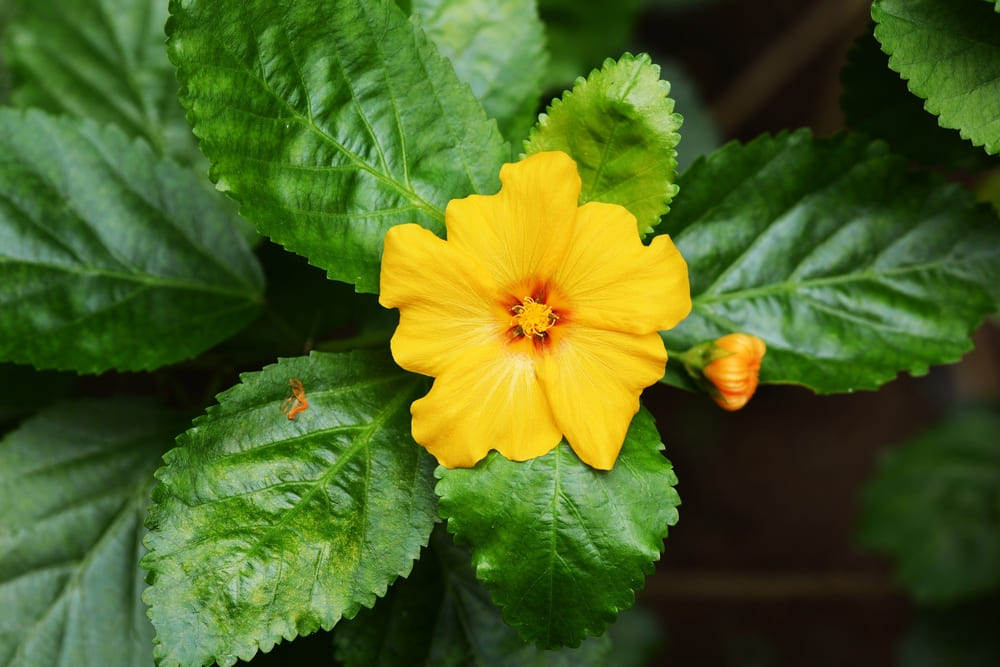
Hawaii has a wide variety of tropical flowers. Some are rare and endangered. The Hawaiian hibiscus shrub is critically endangered. But there are several common flowering shrubs that are still thriving in Hawaii. You can see them in bloom in the forests, gardens, and lawns.
Ilima, golden mallow, and camomile are some of the most common and popular tropical flowers. These colorful plants have long been used as food in a number of countries. They have also been found in ancient times. They have been introduced to the United States, Turkey, and Israel, among other countries.
Ilima is a small flowering shrub. Its flowers have a light yellow color. They look like miniature Hibiscus blossoms. They are quite beautiful when they are strung into a lei. They are tolerant of drought and are wind resistant. They also have soft leaves covered with white hairs.
The Hawaiian hibiscus shrub has a wide range of colors. These brightly colored flowers are found in the forests and beaches of the islands. Its leaves are light green. They can grow up to ten feet high.
33. Forest Gardenia
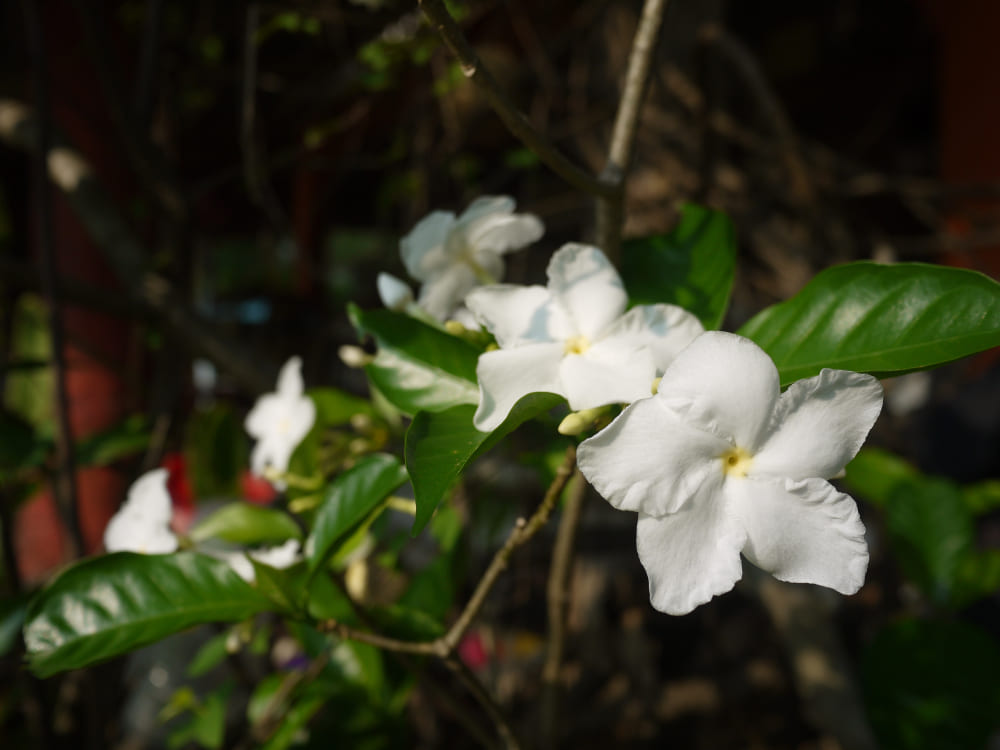
If you are looking for a colorful tropical flower for your garden, look no further than the wild gardenia, also known as the starry gardenia. Its flowers are beautiful, fragrant, and attractive.
The wild gardenia is a member of the Rubiaceae family. It is found in parts of the tropics, and parts of Asia and Europe.
This plant has large heart-shaped leaves that can grow to six feet in size. They are glossy and green, and they come in different burgundy leaf varieties.
The wild gardenia is very easy to care for. Its wood is yellow and dense, and it doesn’t require pruning. It can be bent without breaking.
The gardenia also has unusual fruit. The fruits are hard, and they have a raised dot on the base of the fruit. This helps them to stay on the bush for years. They can be a great choice for hedging or a container plant.
The wild gardenia is threatened by non-native plants. It is also threatened by landslides. The NTBG is working with local, federal, and private conservation partners to protect the plant.
34. Blue Passion Flower

Passion Flower is a tropical flower, native to South and Central America. Some varieties are edible, while others are cultivated as ornamentals.
The plant can be grown in a number of climates, including hot, cool, and temperate regions. The Passiflora genus has over 500 species.
This plant is an excellent choice for a garden or wall plant. It grows quickly and requires little maintenance. It will provide a colorful bloom and attract butterflies. It is an excellent choice for indoor gardens, patios, and trellises.
Passion flower plants can be propagated through cuttings. Cuttings should be taken from young growth stems. These should be dipped in powdered rooting agents. They can be planted in the garden eight weeks after rooting. It is a good idea to plant the cuttings in a well-drained soil and cover them with a mulch.
Passion flowers can be grown in a variety of climates, but they are best suited to full sun or partial shade. They also prefer well-drained soil.
Passion flower plants need to be watered frequently. They will need deep watering during the growing season and more watering in the winter. They can also benefit from compost to retain moisture.
35. Orchid Trees
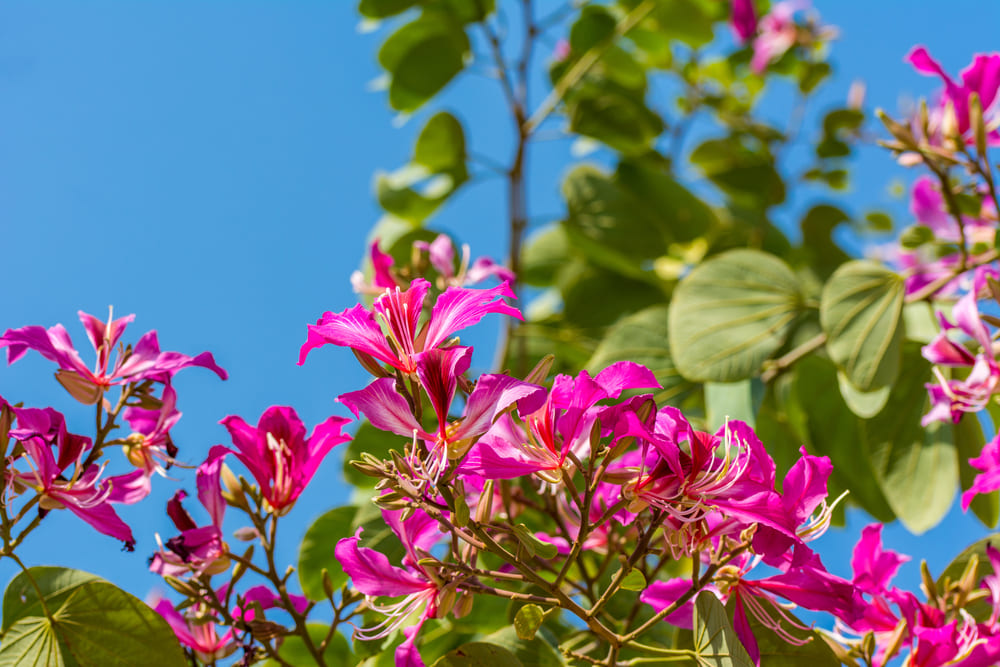
If you are interested in adding a tropical accent to your garden, consider planting Orchid Trees. They will add a bold and beautiful feature to your yard, patio, or driveway. These trees can also be used to create shade.
Orchid trees are one of the easiest plants to care for in the United States. Their rounded leaves are leathery, glossy, and have twin lobes. They are best planted in well-drained sandy soil that is moist, but not soggy. Alternatively, they can be grown in pots. They will require a gallon of water per watering.
In cooler climates, potted plants may need more frequent watering, as the soil dries out faster. Be sure to check the soil moisture level before watering, though. Overwatering can lead to root rot.
You can use a basic granular organic fertilizer. Mix it with the top layer of soil and apply it in small doses throughout the year. Using a cheap fertilizer with heavy salts can hurt the roots, and the plant itself.
Orchid trees are low maintenance, but they need to be watered carefully to prevent damage to their roots. It is also recommended that you mulch your plant for the health of the leaves.
36. Allamanda
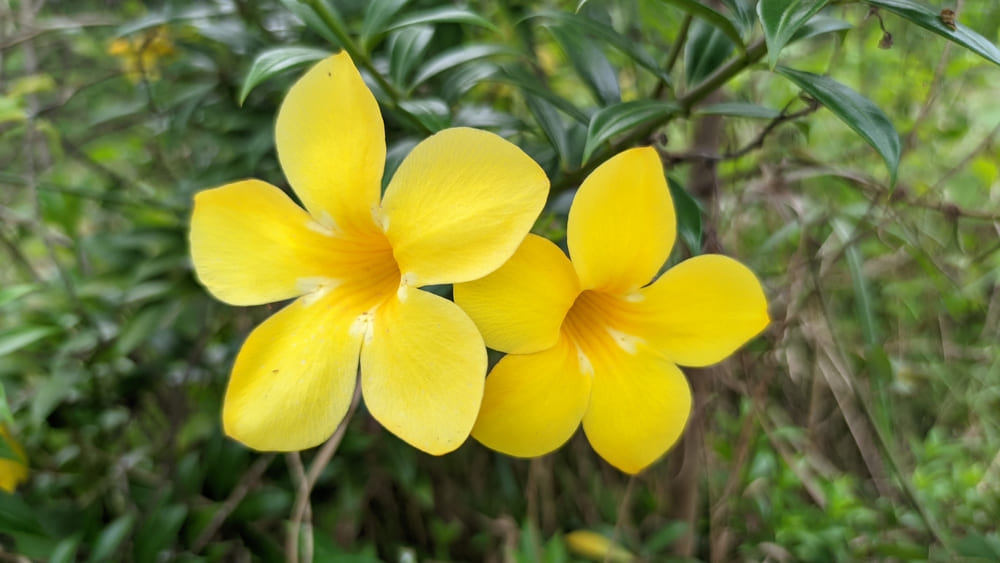
Allamanda is a tropical flowering vine that is widely naturalized throughout the tropics. It is easily grown in containers, as a hedge, or as an ornamental plant.
The Allamanda is a drought tolerant plant, but it needs regular watering in order to grow. It prefers moist, well-draining soil. It will also tolerate light shade. It grows best in pH 5.5 to 6.0. It can be grown indoors, but does not tolerate cold winters.
It is best to grow the Allamanda in sunny, open locations. It can also be propagated from cuttings. It is a low-maintenance plant, but it does require pruning. It is also susceptible to mealybugs. Its parts can also be toxic, so it is best not to let children play near it.
Allamandas can be cultivated in containers or hanging baskets. They need to be given fertilizer regularly in summer and spring. It is best to use a slow-acting, liquid fertilizer that is applied once a week. It also needs plenty of air circulation to prevent fungal attack on its leaves.
37. Morning Glory or Purple Moonflower
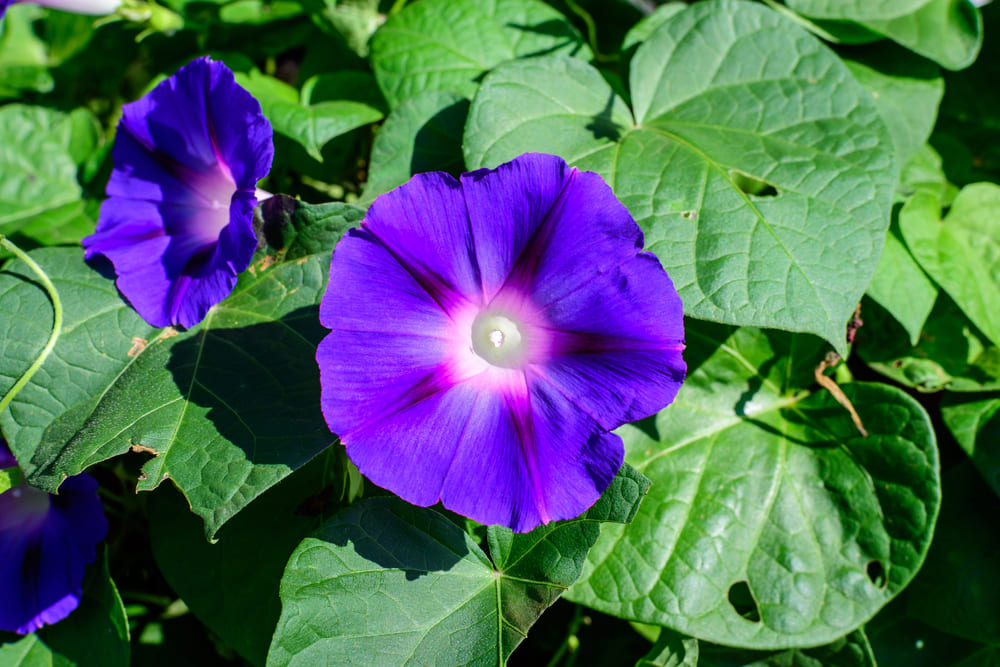
If you are looking for a plant to add some beauty to your garden, a Purple Moonflower can help. It is a tropical flower that grows well in warm climates. It can also be grown as an annual in colder areas.
This plant is a member of the Ipomoea family. It has a strong root system and is often used as a vine.
It has prickly stems and large heart-shaped leaves. The blooms range in size from 6 inches to 7 inches. They can be white or purple. The blooms are fragrant and can add an exciting and colorful display to your garden.
There are many varieties of this flower. Some are more toxic than others. It can be poisonous if consumed, so it is best to keep it out of the reach of children.
This flower can be a great addition to your night garden. Its blooms will stay open through the night. However, they will close when the sun rises.
It can be planted in your garden or in a pot. It has a tendency to wilt if the ground is dry. Watering it is recommended at least twice a week when the weather is sunny.
38. Kahili Ginger

The Kahili Ginger is a tropical plant that grows well in the tropics and can be used as an architectural garden shrub. It produces yellow or red flowers with long stamens and has a wonderful fragrance.
It is native to the Himalayas and Nepal, and has been introduced to the islands of Hawaii, New Zealand and French Polynesia. In Hawaii, it is considered an invasive weed.
The plant has a thick rhizomatous root system. Its thick leaves and dense spikes look exotic and lend a tropical feel to the landscape. The lily’s flowers appear in late summer and early fall and are long and fragrant.
It is a popular landscape ornamental plant and is often planted in patios and gardens. It is also a good choice for a hedge plant. The foliage of this plant is useful for providing essential oil for soaps and shampoos.
The Kahili Ginger’s name comes from Hawaiian word kahili, which means “feather standard”. The plant’s large, banana-shaped leaves are yellow or red and have long stamens.
The plant is a member of the Zingiberaceae (ginger) family. The scientific name is Hedychium gardnerianum.
It is a popular landscape ornamental with bright yellow flowers. It is best suited for planting in sunny, humid areas.
39. Powder Puff Flower
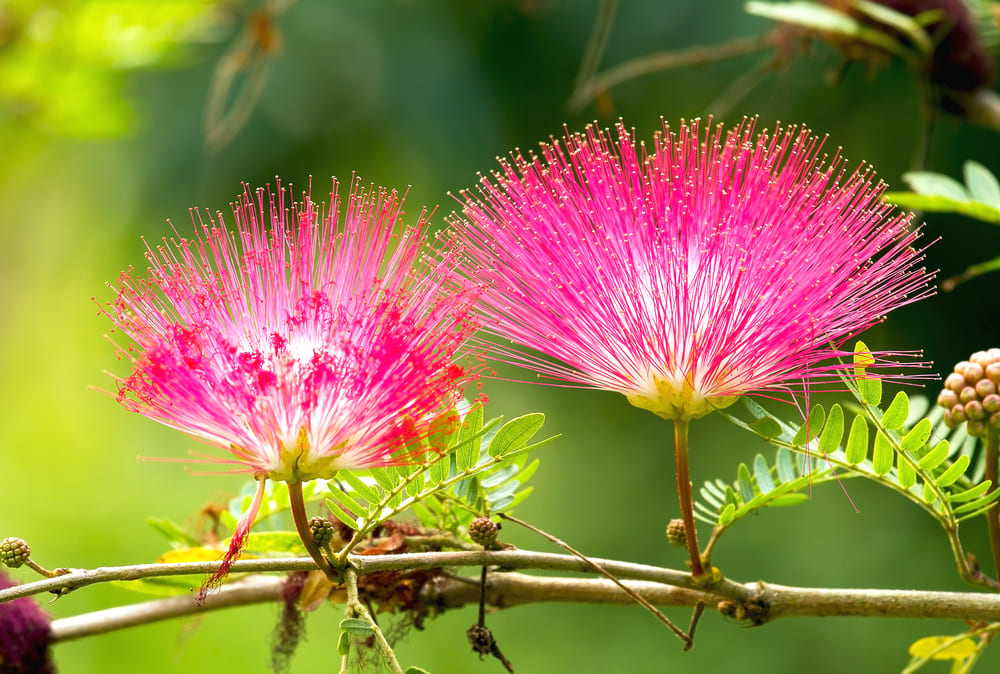
In addition to being a popular ornamental plant, Powder Puffs are also known as fairy dusters. The plant has beautiful decorative white or red flowers. It is an ideal indoor house plant, and the blooms last all year. It is also a favorite of hummingbirds.
The pink and red varieties of the plant are the most popular. They are easy to care for, and they have showy flowers. They are also known for their fragrance. However, they are not hardy outside, so you’ll need to take precautions if you’re growing them indoors.
When you plant them, you should be prepared to water them regularly. They also require bright sunlight, so you should be sure to provide it. For this reason, it’s best to place them in a sunroom.
You can also grow Powder Puffs from stem cuttings. These plants need a warm climate, and they should be repotted every year or two. In addition, you’ll need to water them more frequently in the summer. For the most part, you’ll want to give them a good amount of fertilizer in the spring.
The foliage of the plant is a bipinnate leaf pattern, and the leaves close at night. It’s also known for its long stamens. The plant’s name comes from the circular shape of the stamens.
40. Molokai Ohaha
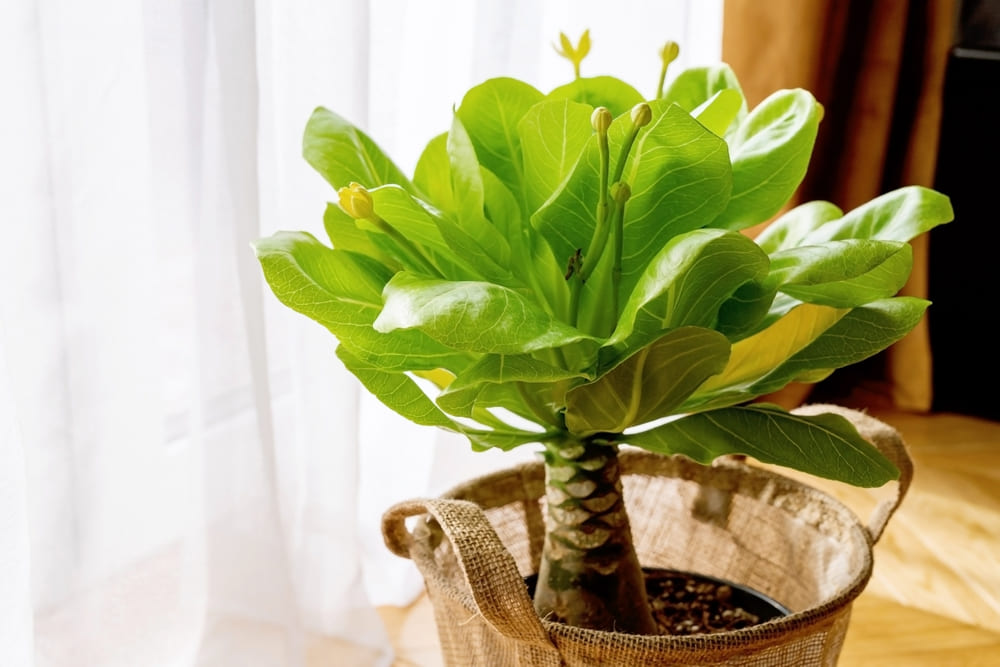
There are many kinds of Hawaiian flowers. Some are native to Hawaii and others are cultivated. Some plants are endangered.
The Hawaiian Hydrangea is a beautiful flowering shrub that is native to Hawaii. The flowers are brightly colored and long-lasting. The berries are also attractive to birds. The plant is a member of the Hydrangeaceae family. The Hawaiian Hydrangea can be found in mesic forests, wet forests, and dry forests.
The Ohi’a Lehua is an evergreen tree with a showy blossom. It is considered sacred by the native Hawaiians. Traditionally, it was believed to have a special relationship with Pele, the volcano goddess. It is hardy and resistant to fire. It is often used for cut flower arrangements.
The Molokai Ohaha is one of the most endangered flowering plants in the world. The native population is estimated at less than 200 plants. The plant is native to Molokai. The foliage forms a rosette, which is followed by multiple inflorescences. The plants grow to about 16 feet tall.
The plant is native to higher elevations of Hawaii. It grows naturally in dry areas, and is drought-tolerant. It produces silvery-green leaves.
The plant can be grown indoors, but it should be placed in a spot where it will receive direct sunlight. The flowering season of this plant is during late winter to spring.
41. Kadupul Flower or Queen of the Night Cactus
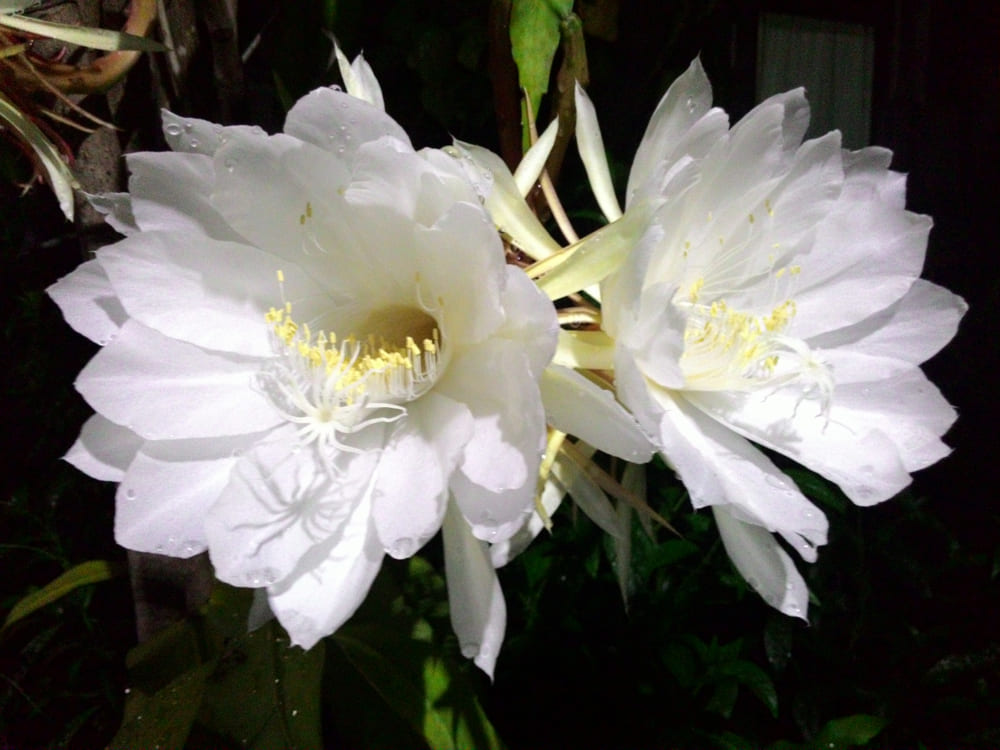
The Kadupul Flower is a rare and exotic plant from Sri Lanka. Its scientific name is Epiphyllum Oxypetalum. This plant has become very popular around the world. It is also referred to as the Queen of the Night.
The Kadupul flower is known to be associated with the Nagas, a Hindu deity. It is believed that the flower is sent down by the Nagas from the heavens. It is a rare flower that usually only blooms for a short period.
The Kadupul flower is considered to be very beautiful because of its broad and sweet petals. It also releases a sweet fragrance when it is in the blooming process.
The plant is hardy and can grow well in climates of 50 to 90 degrees Fahrenheit. However, it is advised to avoid freezing temperatures.
It can be grown indoors or outdoors. It is best to keep it in a place where it can get indirect sunlight. It also needs light soil. It requires watering once every two weeks, but not too often.
The plants live off of dead leaves and bird droppings. They prefer to be grown in clay pots. Keeping the plant in too much direct sunlight can cause the buds to get damaged.
42. Sampaguita or Arabian Jasmine
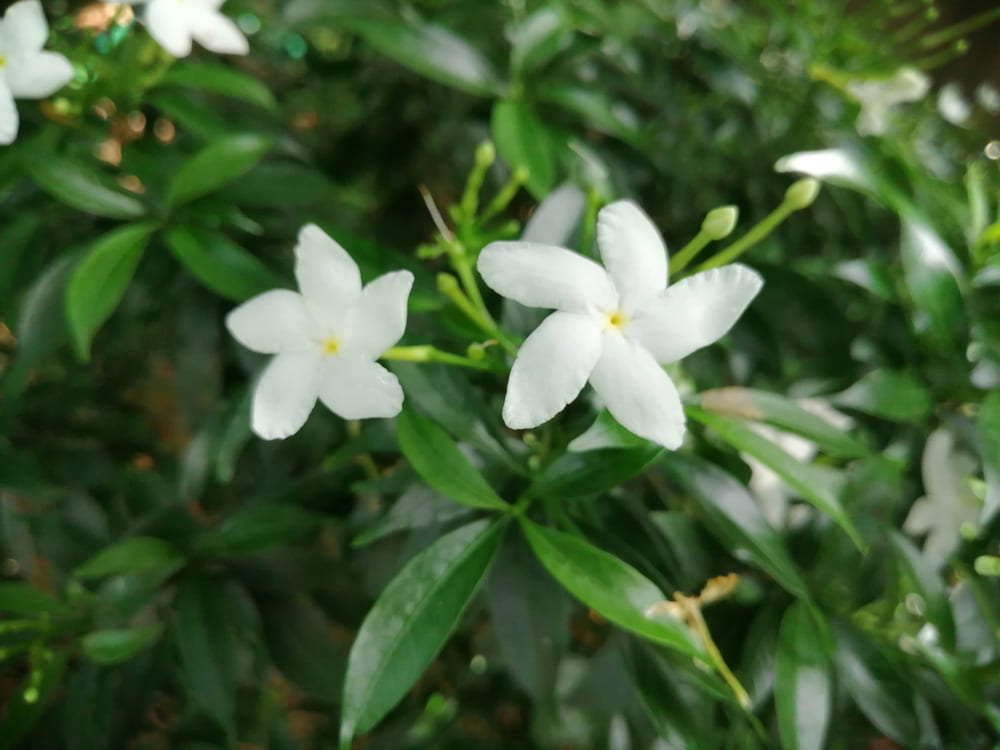
The Sampaguita or Arabian Jasmine plant is a beautiful, evergreen shrub. It grows in tropical climates. The shrub can grow up to a height of 3 meters. It is a good choice for landscaping. During the flowering season, a large plant can produce 100 flowers per week.
The shrub’s leaves are oval in shape, with a rounded tip. They are about 6 to 12 cm long. The plant produces a fragrant sweet scent. The flower is white with elongated petals. The plant also produces an oil that is used in perfumes. The leaves contain antioxidants that help fight oxidative stress.
The plant is not prone to serious pest problems. However, it is important to properly care for the plant. A good root structure and healthy soil are essential.
The plant is grown for its fragrance. It can be used as a decoration, and is a good choice for religious ceremonies. The roots of the shrub are also used as medicinal treatment for snakebite. Moreover, the extract is also used for making soaps.
The plant can be propagated through seeds and stem cuttings. The seedlings can take two years to reach maturity.
The plant prefers part shade to full sun. It should be kept in a well-draining and humid soil. Water the plant regularly and fertilize it once a month.
43. Tobacco Flower

Flowering tobacco, also called nicotiana, is an ornamental plant that belongs to the Solanaceae family. It is native to tropical South America. This herb produces white, fragrant flowers that open at night.
This aromatic flowering plant grows best in partial shade to full sun settings. It’s an easy-to-grow, low maintenance flowering plant. It can be grown as an annual, or can be planted in a container for growing indoors.
When grown as an annual, Tobacco will require regular watering and a warm environment. It should be planted in full or part sun, and in a rich, nutrient-rich soil. It will also need a temperature of 72 to 78 degrees Fahrenheit.
Tobacco plants are often grown as bedding plants or specimen plants. They are also popular for their flowers, and are used as a focal point in a garden.
Flowering tobacco grows from early summer until the first frost in the fall. It can survive the winter if kept in a warm, bright place. However, it may need watering more frequently during the blooming season.
Various varieties of the Tobacco flowering plant are available, but all are fragrant. Colored varieties are pink, red, or white.
44. Mussaenda
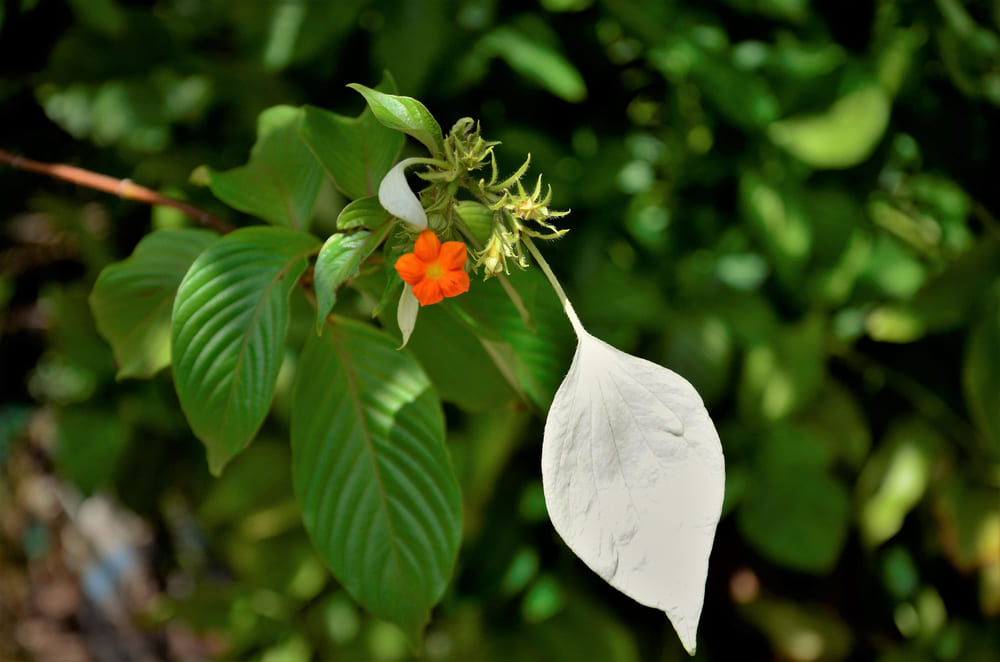
The Mussaenda is a tropical shrub with large showy flowers. The blooms range from pink to white and are generally star-shaped. The bracts are colorful and often yellow.
The Mussaenda grows as a bush or tree, and can be used as an accent plant or in landscape beds. It can also be grown in containers.
The Mussaenda is a member of the Rubiaceae family. Its leaves are elliptical, and are green or yellow. The plant produces one large, showy petal per flower. The sepals are usually pink, but some cultivars have orange sepals.
The Mussaenda can be grown in cooler regions, although it prefers warm, moist conditions. It grows well in full sun or partial shade. The leaves are elliptical and deep green. During a drought, the leaves will droop. It is best suited for a drip system to keep the moisture level high.
The Mussaenda philippica is the most commonly cultivated species. It is the parent of most hybrids. It has numerous cultivar forms, ranging in height from 2 feet to 15 feet. Some of the more recent Mussaendas are only available in Asia.
The Mussaenda is an ideal choice for butterfly gardens. The flowers are appealing to bees, butterflies, and birds. They are also highly decorative in tropical areas.
45. Begonias
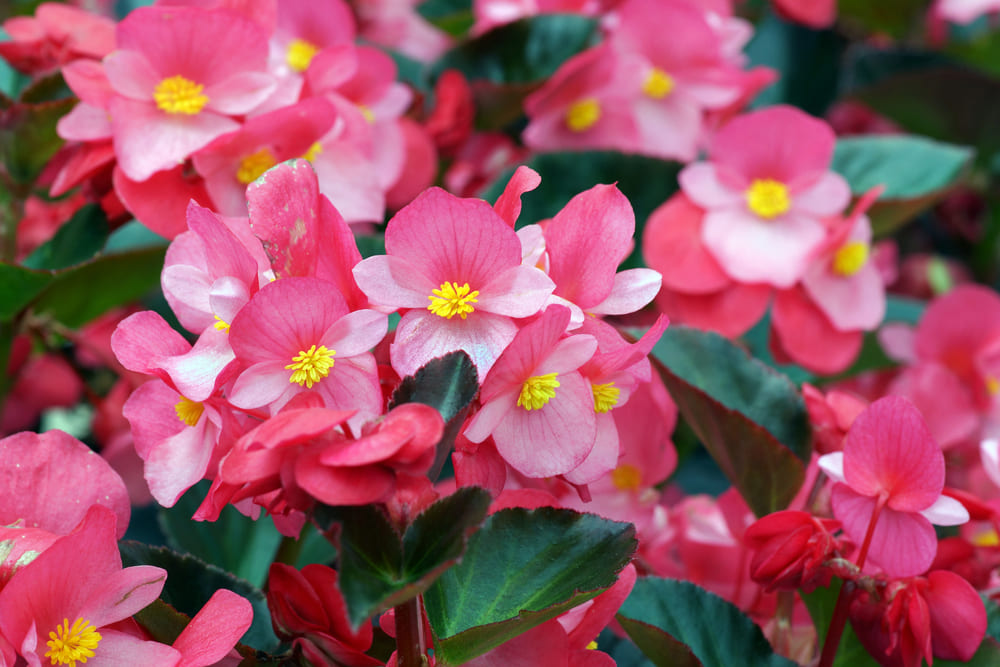
If you’re interested in bringing a tropical flower indoors, begonias are a great choice. This type of flower is very easy to care for. You’ll be surprised at the number of varieties available.
They can grow in a variety of soil types, so you should use your judgment when choosing a suitable variety. You should also be careful to avoid overwatering. Watering from the bottom will help prevent stem rot.
Depending on the variety, you can expect your begonia to grow to a maximum height of 2 meters. They’re known for their attractive foliage. Some types have large, colorful flowers.
Tuberous begonias are popular houseplants. Their long, soft canes spill over the edge in a display of color. They’re perfect for terrariums. They’re also good as hanging basket plants.
They’re very hardy, but they should be protected from harsh afternoon sun. If you have an outdoor begonia, you can place it in a sunny window in the early spring. This will encourage it to start blooming.
They can also be brought in for overwintering. Most have a hard time surviving in a cold climate. However, there are many varieties that are hardy in cooler regions.
46. Freesia
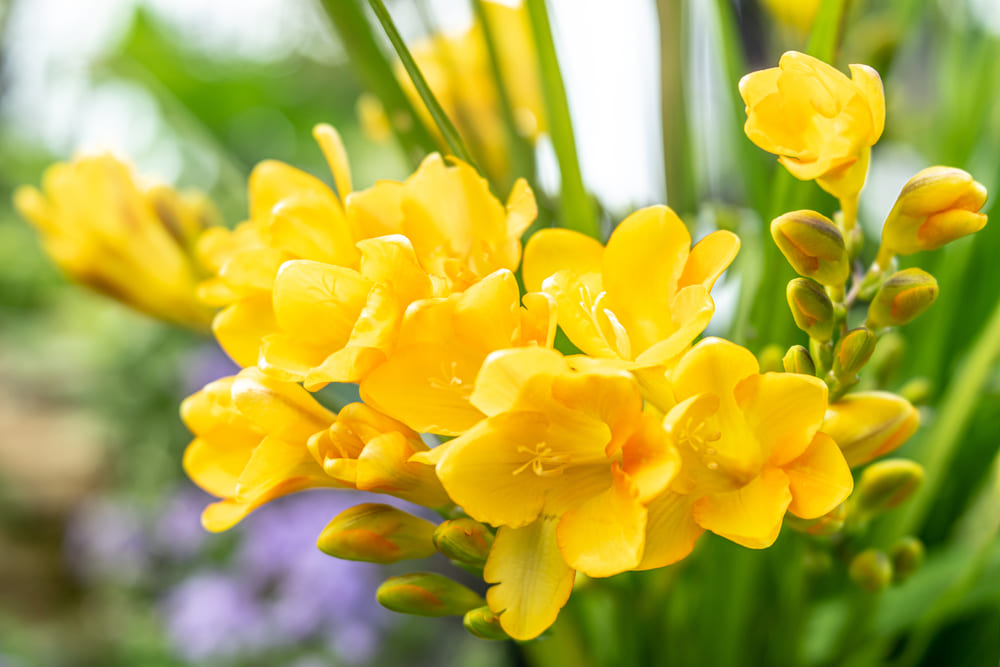
Freesia tropical flowers are very fragrant and add beauty to a tropical garden. They come in a variety of shades, including bright white, yellow, and red. They are also sold as cut flowers.
Freesias are relatively easy to grow. They prefer well-drained soil and can be planted in pots. They require about an inch of water per week. It is important to water when the foliage begins to turn yellow. It is also important to keep the plant out of direct sunlight.
Freesia bulbs can be planted in fall. They will bloom in the spring or early summer. The corms should be planted a few inches deep and a few inches apart. When they are finished flowering, they can be stored in a cool place for the winter. They can be stored in sand or peat.
Freesias need plenty of organic matter. They are prone to rot in wet or saturated soil. It is best to use compost or a mixture of potting soil with added grit. The plant will also benefit from a staking system. You can use a slender bamboo stake.
You can start the seeds indoors in late April or early May. When the seeds sprout, they should be planted in a potting soil with added grit. It is important to feed the plant every month.
47. Crown Imperial

The Crown Imperial is one of the most exotic tropical flowers, and is also known as Fritillaria. This beautiful plant can be grown in containers, as well as in the ground.
The Crown Imperial is a member of the lily family, and it comes in several different varieties. The most popular variety is the Rubra Crown Imperial, which has bright red petals. The foliage of this plant is also very attractive. Its foliage is glossy and arranged in a long, narrow, upright shape.
The Crown Imperial can grow to three feet in height, and it can produce a whorl of bell-shaped flowers. The flowering period is usually from mid-April through June.
The flowers have a red color and are rounded, oval-shaped, pointed, and vertical stripe-textured. Their petals are orange, yellow, or red. This plant is an excellent choice for a backyard garden. It can be used in perennial borders, cottage gardens, and woodland areas.
This plant has a distinct scent. It is also a deer-resistant plant. It can tolerate drought, but it does need to be watered on a regular basis.
The Crown Imperial is best grown in large pots and planters. Its flowers appear in clusters of ten. It is an ideal plant for gardens with daffodils and tulips, but it also blends nicely with other bulbs.
48. Canna Lily
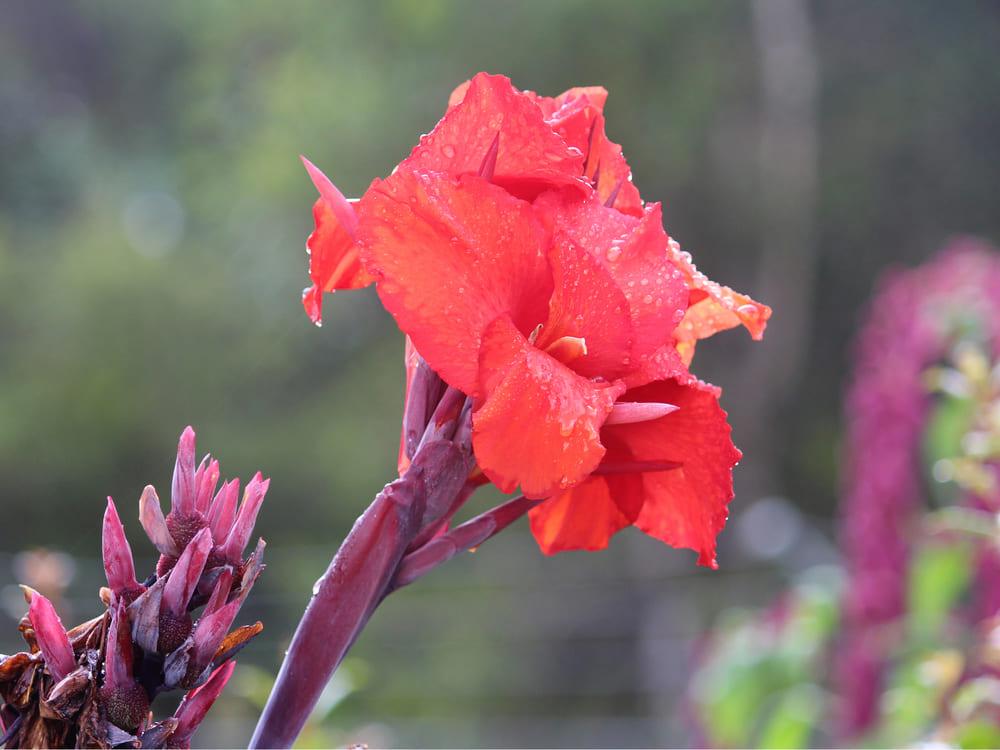
Cannas are herbaceous perennials that grow well in a variety of soils and conditions. They are a great plant for a pond or water feature. They are also ideal for a tropical garden. They grow tall and can take full sun or shade.
Cannas need to be grown in rich, moist soil with a pH between 6.0 and 6.5. They do not tolerate drought very well. They are heavy feeders and need consistent moisture. They should be watered 1-2 inches a week. They should be kept in a pot or a large container.
Cannas can be propagated by rhizome division. The rhizome is a fleshy underground rootlike structure. The tip of the rhizome produces a new stalk. The rhizome should be planted a few inches deep in well-drained soil. Generally, canna rhizomes have three or more eyes. The more eyes, the more leaves the rhizome will produce.
In spring, add two to four inches of manure to the soil around the base of the plant. The canna lily prefers full sun. In colder climates, protect the bulbs from frost.
To keep the Canna healthy and beautiful, fertilize it every six weeks. A slow-release fertilizer is ideal. This allows the Canna to take up all the nutrients it needs without overfeeding.
49. Pentas
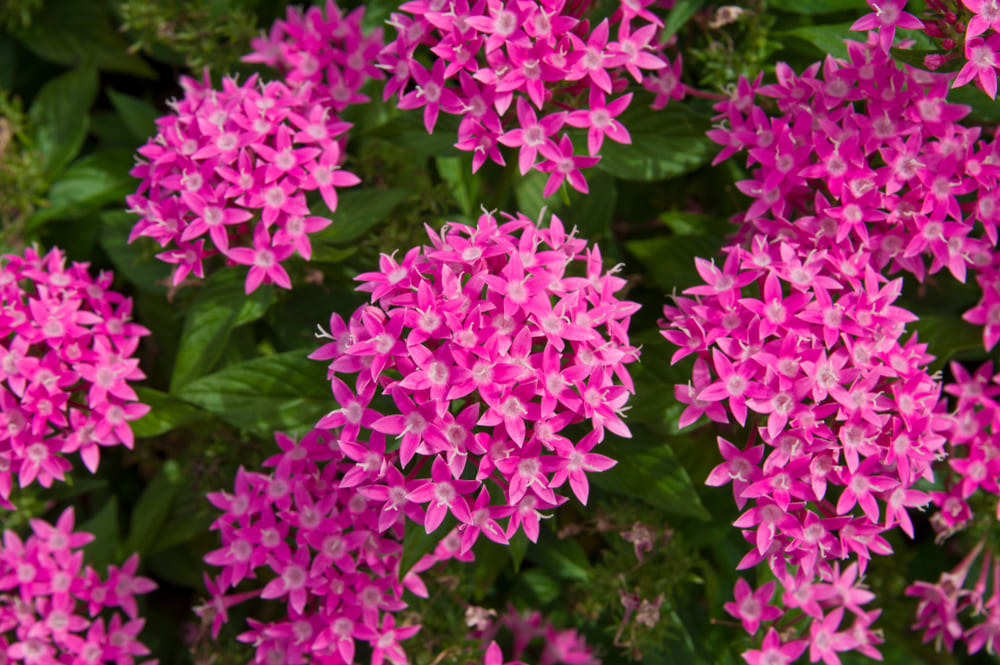
Pentas tropical flowers are a great addition to any sunny flower garden. These plants grow well in pots, hanging baskets and containers. They are also a favorite of hummingbirds and butterflies. They are carefree and drought tolerant. They are native to Africa.
Pentas can be grown from seeds, cuttings and transplants. They are best planted in full sun. They like a moist soil with a pH level of 6. They can also tolerate partial shade. They are a perennial in warm climates, but can be brought indoors in cold weather.
Pentas should be watered thoroughly to keep them healthy. They require a minimum temperature of 55 degrees F. Keeping the soil consistently moist is also important. It is recommended that you water the plant at least an inch a week during the growing season. You can also use a slow-release fertilizer.
Pentas are a popular plant for hummingbirds and butterflies. These insects love the large clusters of flowers on the plant. They are also prone to spider mite infestations, so a regular treatment with insecticidal soap and natural oil will help protect them.
A thick layer of mulch around the plants will help keep the soil moisture and prevent weeds from sprouting. The plants should be moved to a more sheltered spot once the weather starts to change.
50. Clivia
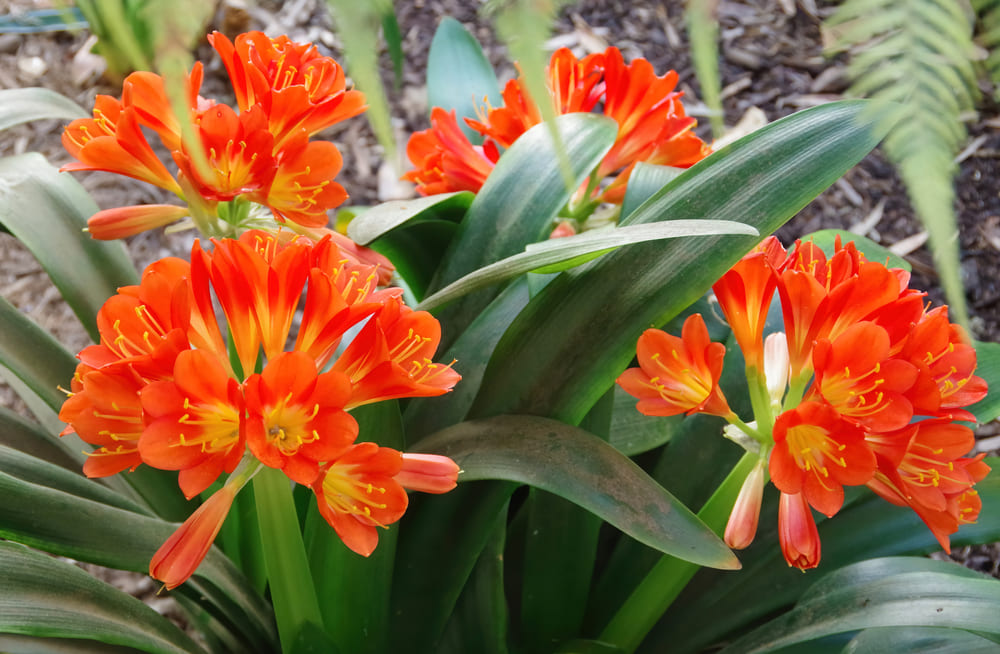
Clivia tropical flowers are a beautiful addition to your garden. These plants are native to subtropical South Africa and are known for their vibrant orange flowers. They can be grown indoors or outdoors.
Clivia plants are a member of the amaryllis family. They bloom in shades of red, apricot, and orange. Some varieties also have white or green stripes on their leaves.
These plants are easy to grow, but they do need a lot of care. In particular, they require bright light and a regular watering schedule. It is important to remember that clivias are not suitable for humid conditions. It is best to avoid direct sunlight, which can burn the leaves.
If you decide to keep your clivia indoors, it’s a good idea to use a room humidifier. The plant’s leaves can become a food source for aphids, fungus gnats, and mealybugs. If you notice any signs of these pests, treat them immediately.
A good option for a humidifying system is a cool mist room humidifier. These can be purchased in stores. You can place your clivia on a pebble tray to help control the humidity.
To keep your clivias in tip-top shape, remove the leaves and clean them with a damp cloth. You can also trim the stems to discourage the formation of seeds. This will make the plant stronger and encourage new healthy growth.
51. Maraca Ginger
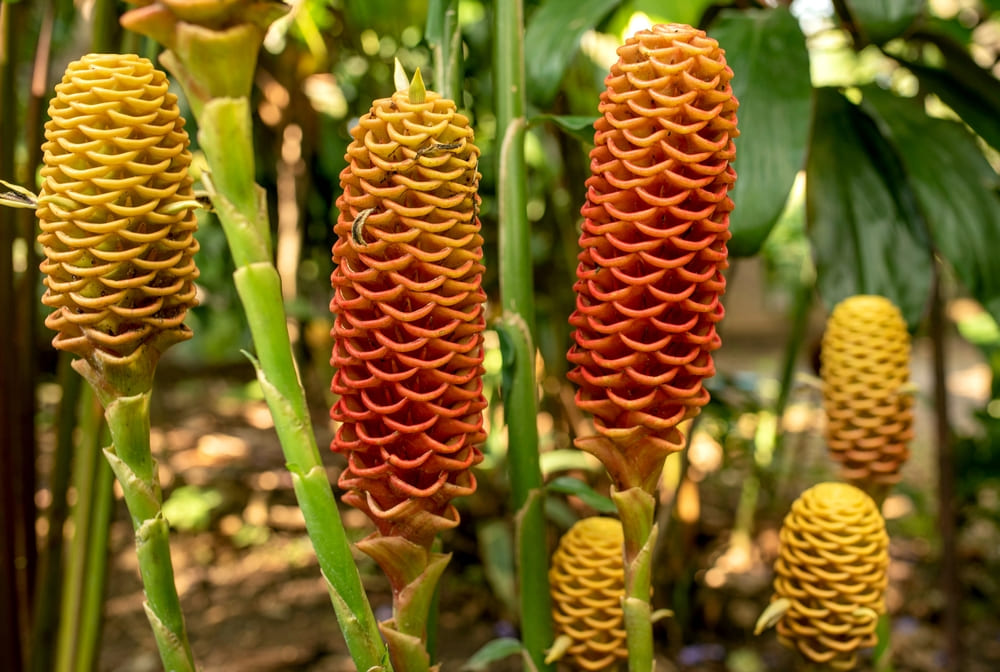
If you are looking for a little something extra in your floral arrangements, you might want to consider Maraca Ginger. This tropical flower has long narrow leaves that are arranged haphazardly on its stems. In the summer, the plant produces a tall, conical stalk, resembling a pinecone.
This particular tropical plant may not be suitable for an indoor arrangement, but the resulting show is worth the effort. Whether you are looking to brighten up a friend’s home or office, or you are just interested in adding a splash of color to your garden, this tropical plant is the perfect choice.
While the plant itself has a bit of a reputation for causing toothaches, this particular flower is actually a pretty good cut flower. And with a bit of proper care, you can make it last for a very long time.
There are several types of Maraca Ginger, but the most common type has long, conical stalks resembling a beehive. In addition to its colorful appearance, this plant is also known for its medicinal benefits. One of its best known uses is as a natural remedy for stomach problems. In fact, it has a long list of medical applications, including a treatment for malaria.
This flowering plant is actually part of the Zingiberaceae family, and it has 52 different species. Its leaves are generally glossy green, and the stalks can reach a respectable 7 feet tall.
52. Urn Plant

Urn Plants are a beautiful home plant that are very easy to care for. They are one of the most popular types of potted plants. They are commonly seen on tables and mantels in homes. They are also a good choice for people looking for exotic plants to add to their decor.
Although urn plants require less watering than other plants, they still need to be regularly watered. They prefer a moderate to warm temperature range. They perform best in partial shade, but they can tolerate some sun.
They can grow up to a few feet tall. They are generally hardy, and they have a beautiful life cycle. However, they are susceptible to scorching and root rot if they are overwatered. To avoid these problems, it’s best to know how to water urns properly.
The best way to tell if your urns need watering is to check the top inch of the soil. If it feels dry, then it’s time to water. The same holds true for container-grown plants.
Overwatering can cause the crown of the urn to rot. It can also cause rotting of the leaves. To prevent this problem, keep the plant in a container with a slightly damp growing medium.
The best type of water to use on burns is rainwater. Some urns will even survive droughts.
If you decide to plant urns indoors, you should place them in a room with a mix of shade and bright light. You can mist them to create a humid environment.
53. Red Frangipani

Whether you’re looking for a plant for your garden or you just want to add some tropical flowers to your patio, frangipani is an easy-to-grow option that is both beautiful and durable. It’s also one of the easiest plants to grow from cutting.
Frangipani is a tropical tree that has beautiful blooms in the spring. It is a common plant in Thailand and the Philippines. It’s also a favorite in decorative containers. It makes a great freestanding specimen, too.
It’s also a good host for dendrobium orchids. It’s hardy, salt-tolerant, and drought-resistant, making it a perfect candidate for your outdoor or indoor garden. It’s also a good choice for a mixed shrub border, and can be used as a patio tree.
The tree’s flowers are lovely, orange-yellow. They’re perfect for a cut flower or as floating decorations on a pool. It’s also the national flower of Nicaragua and Laos.
When growing frangipani indoors, it’s important to make sure your plants get adequate moisture. It’s also a good idea to provide your plants with a slow-release fertilizer every few weeks.
When you’re deciding on a watering schedule for your plants, you may need to experiment with different types and amounts. For example, you can try watering once a week, every other week, or every two weeks. Depending on the amount of rainfall your area receives, you might need to increase or decrease the frequency of watering.
54. Calla Lily

If you’re looking for a long-lasting cut flower, the Calla Lily is a great choice. It’s a hardy perennial that grows well in tropical climates. It can be grown in containers or in the ground.
The flowers of the Calla Lily come in a range of colors. They can be white, yellow, or pink. The spadix, the finger-like center of the flower, can be red, orange, or peach.
Callas are generally hardy in USDA plant hardiness zones eight to twelve. They are best planted in full sun and part shade, and they prefer a well-draining soil.
Callas are not winter hardy, but they can be grown as an annual in colder climates. It is important to keep them warm, however. They do not tolerate temperatures below 50 degrees F. They can be overwintered in the garden, but they should be brought indoors for the winter.
When planting callas in containers, it’s important to avoid excessive watering. Overwatering can damage the roots and cause rot. During the growing season, apply a balanced liquid fertilizer as recommended on the product label.
When it comes time to harvest your calla, you can either dig up the entire plant and bring it inside or save the rhizome for replanting next spring. You can also overwinter the rhizome in the garden and plant it out when the weather is warmer.
The best time to plant callas is in the spring or after the last expected frost. Callas should be planted three to four inches deep in a moist, porous soil. The rhizomes should be planted at least one foot apart, with the tips of the plants facing up.
55. African Lily
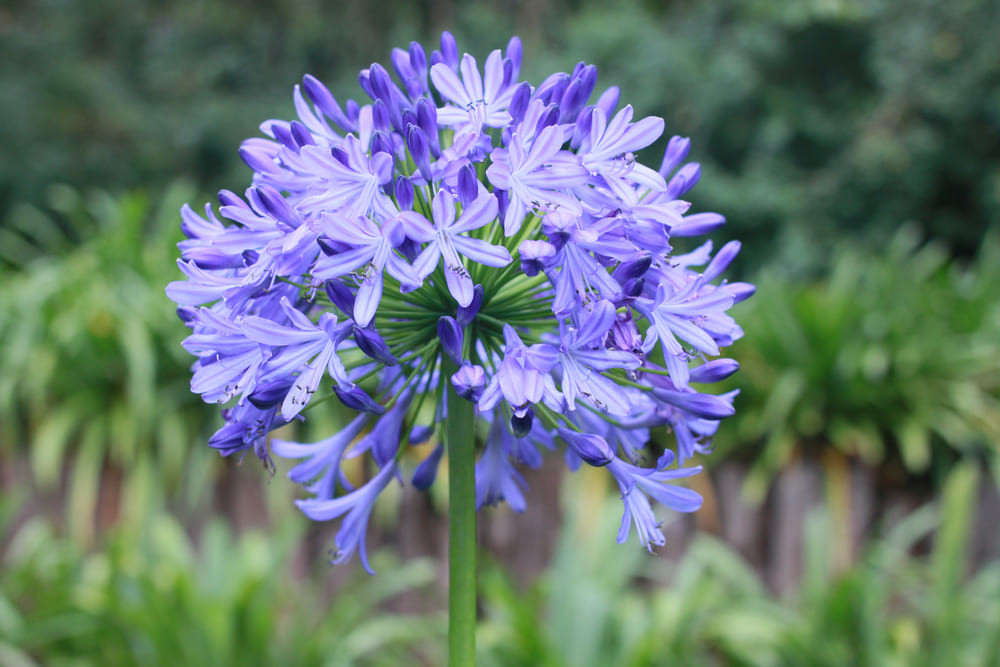
When it comes to a tropical flower, the African Lily stands out. This lovely plant will add color and texture to any garden. Whether you’re planting it in the ground or in a container, this versatile perennial is easy to care for. It also looks beautiful as a cut flower, making it a perfect addition to any home.
The African lily is a low-maintenance perennial. It will tolerate heat and drought and will thrive in full sunlight. It requires regular watering, and it may take two to three years for it to bloom. It’s a great addition to mixed borders or a cottage-style garden. It also attracts birds and butterflies.
These flowers are usually blue, but they can be found in other colors. When you purchase them, make sure to plant them in a well-drained, rich, moist, and sunny spot. You’ll want to repot them periodically, and it may be best to place them in a shady location for part of the year.
The African Lily is native to Southern Africa, but it can be found in other areas around the world. It’s considered a pest and disease free plant. Its flowers are ornate and showy, rising atop a dense clump of narrow leaves. The foliage is curved, and the plants are typically planted in rows. They’re also very attractive when they’re not in bloom.
Depending on where you live, the African Lily will vary in height. They can grow to about two to three feet. They can be grown indoors or outdoors, but the sun-loving plant prefers a cool-mist room humidifier. They’re easy to care for, and they are a great addition to coastal areas.
56. Bat Plant
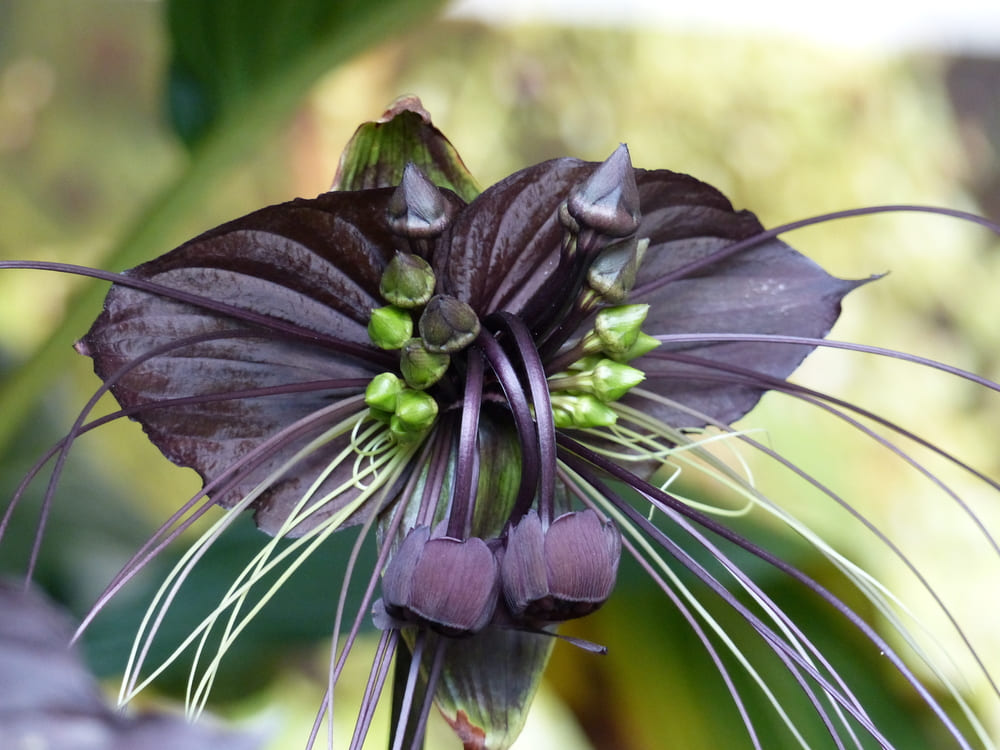
Bat Plant tropical flowers come from the subtropical forests of Asia and Southeast Asia. This is a very interesting plant that grows in a variety of different places around the world. This plant is unique in that its leaves have long bracteoles that resemble whiskers.
These bracteoles are a modern evolutionary development that probably helps support the reproductive success of this species in the wild. The filamentous bracteoles also help protect the plant from herbivores.
The flower is quite dramatic, with its dark purple to black color, and its wings-like bracteoles. It can be a conversation starter.
This tropical flower can be grown indoors. However, it does not like to be too wet. In order to give it the best chance, you should grow it in a container. You should use rich soil and keep it well aerated. This will also improve its root system.
Tacca chantrieri is a perennial plant that is native to tropical regions of Asia. It is cultivated for its unusual inflorescence. The inflorescence is composed of small hanging flowers. The foliage is also characterized by a tuft of basal leaves and large leaves at the base of the stem.
It has been collected from the wild in China, Thailand, Myanmar, and Laos. It is used as an ornamental and horticultural plant.
57. Curcuma Flower
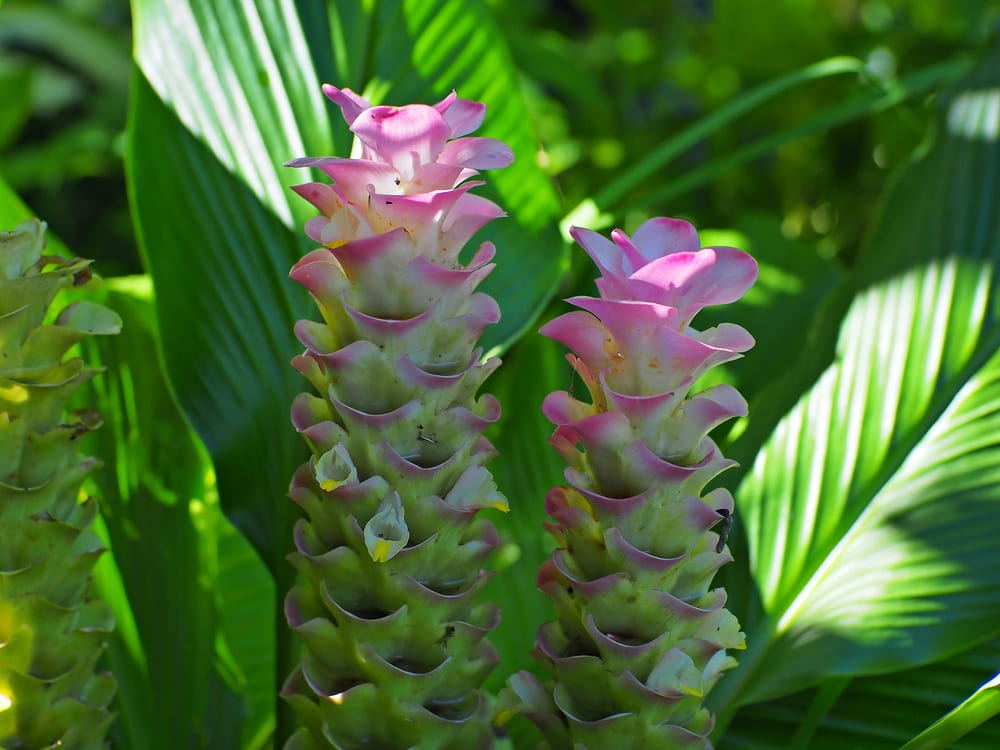
If you are looking for a plant that will add color to your garden, look no further than Curcuma. It is an easy plant to grow and produces beautiful flowers. It is also a great addition to a container garden.
Curcuma is a heat-loving plant that grows well in both partial shade and full sun. It can be planted in landscape beds, as an annual, or as a perennial.
The leaves are lance-shaped and have a bitter smell. The plant is usually found growing along the coast of Florida, where it thrives in warm temperatures. It can be grown indoors, but it does best with sunlight and a moisture-rich soil.
Curcuma goes dormant during the colder months. It is very susceptible to bacterial wilt, so it’s a good idea to grow it in a sheltered area. In addition, it requires very little water during dormancy.
If you’d like to grow Curcuma in a container, the plant is extremely easy to care for. The leaves can be pleated to create a textured look. When the foliage dies off in the fall, you can prune it back to keep it looking its best.
A Curcuma plant needs well-drained soil. It is also recommended to use a general-purpose fertilizer. Apply it according to the package directions.
58. Flowering Maple
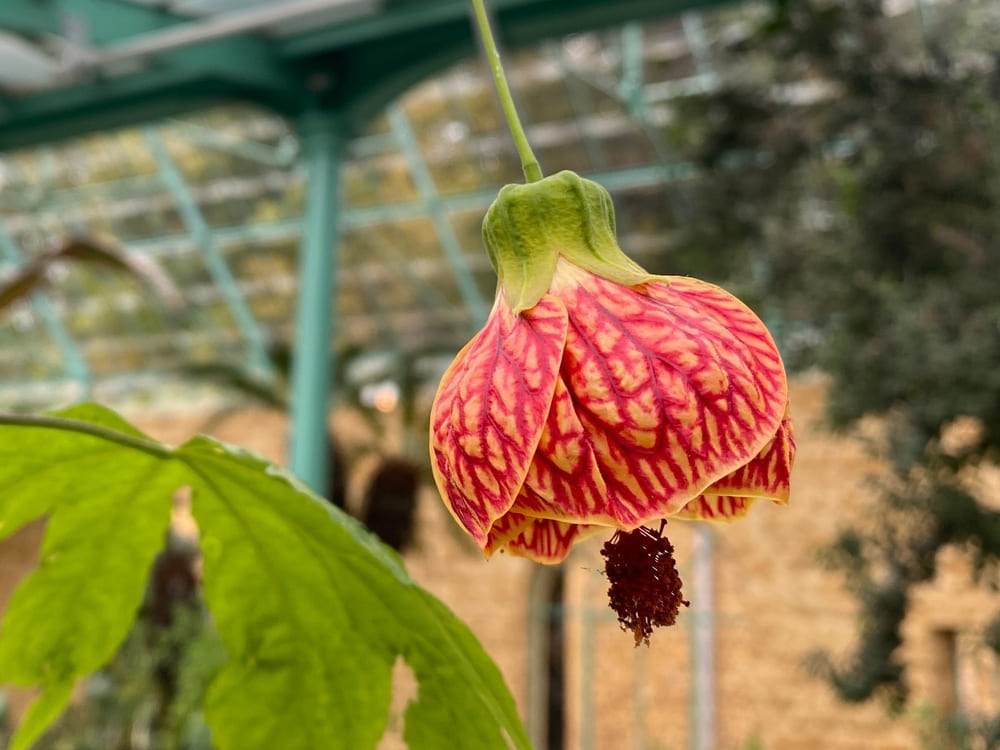
The flowering maple is a small deciduous shrub that grows naturally in South America. Although it can be grown indoors, it is best to put it outdoors during the warmer months. It also makes a wonderful border shrub.
Whether you choose to grow the plant as an indoor garden or as an outdoor landscaping element, it will need plenty of sunlight and moisture. Flowering maples prefer rich, well-drained soil. They will also tolerate some shade, but partial shade may be more appropriate for hot climates.
There are a variety of species to choose from. Some of them are annuals while others can be grown as semi-evergreen shrubs. There are even hybrids between two different maple species.
The flowering maple has no shortage of flowers, although they vary in size and color. Some of the more colorful varieties have orange, red, and yellow petals. Other varieties have white or yellow mottling. They are often pollinated by hummingbirds. They are available in garden centers and online flower delivery sites.
Abutilons are easy to grow. They can be propagated from seed or softwood cuttings. They are typically grown as houseplants. They can tolerate a wide range of temperatures, making them an ideal choice for a cool, summer garden.
59. Angel Wing Begonia
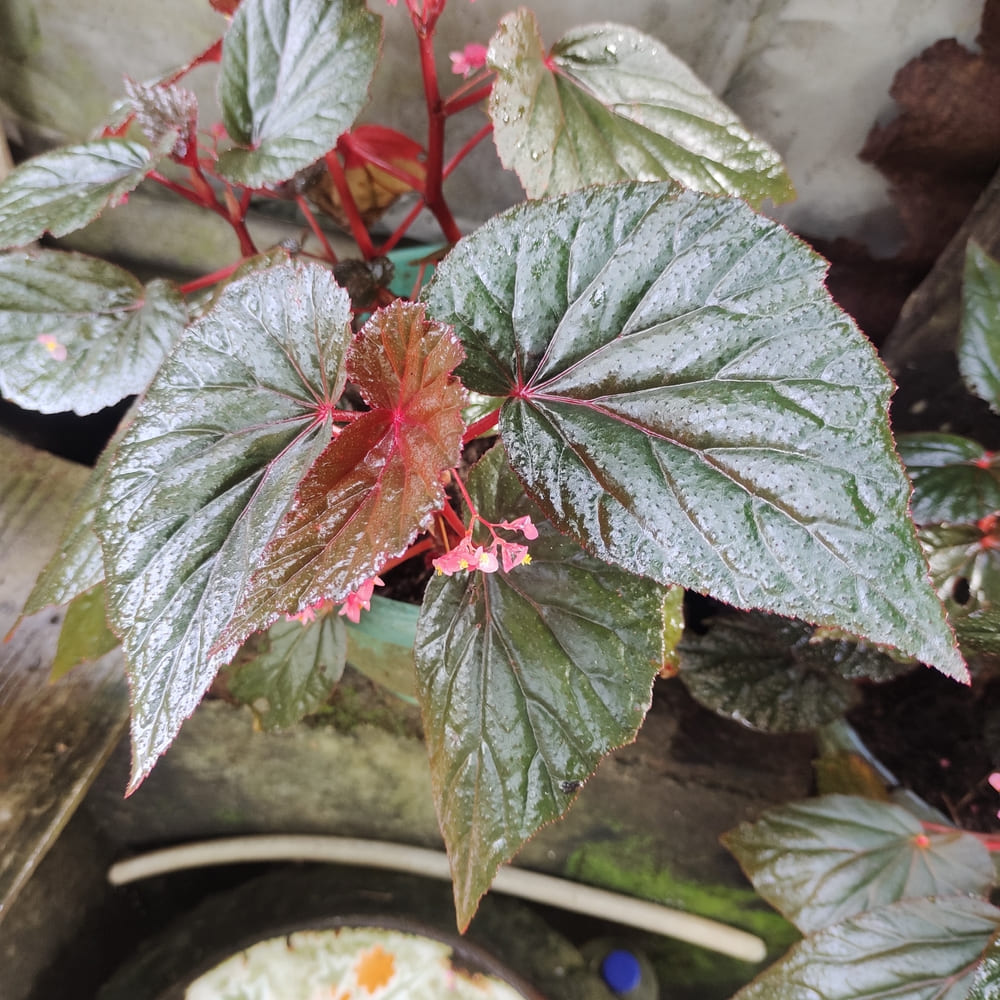
Angel Wing Begonia tropical flowers add a touch of elegance to any garden. It can be a beautiful addition to hanging baskets or containers. You can grow the plant indoors or outdoors in a partially shaded area.
It is an excellent houseplant and it is easy to care for. The flower is pale pink and dangles dramatically from the arching stems. The begonia can be trimmed anytime of the year.
You can easily propagate your begonia by taking stem cuttings. The best time to do this is in the spring. It is also a good idea to keep the cut tips moist.
After you have taken your cuttings, you should place them in a clear plastic bag to keep moisture. The cuttings should be at least six inches long. This will give your begonia room to root.
It is important to water your begonia regularly. Leaving the plant too dry may cause the roots to rot. A good way to avoid this problem is to use a good potting mix. You can also add some peat moss to the soil for better drainage.
If you have any issues with the growth of your begonia, you should treat it with a gentle insecticide. You can use neem oil, which is effective against many common plant pests.
60. Brugmansia X Candida
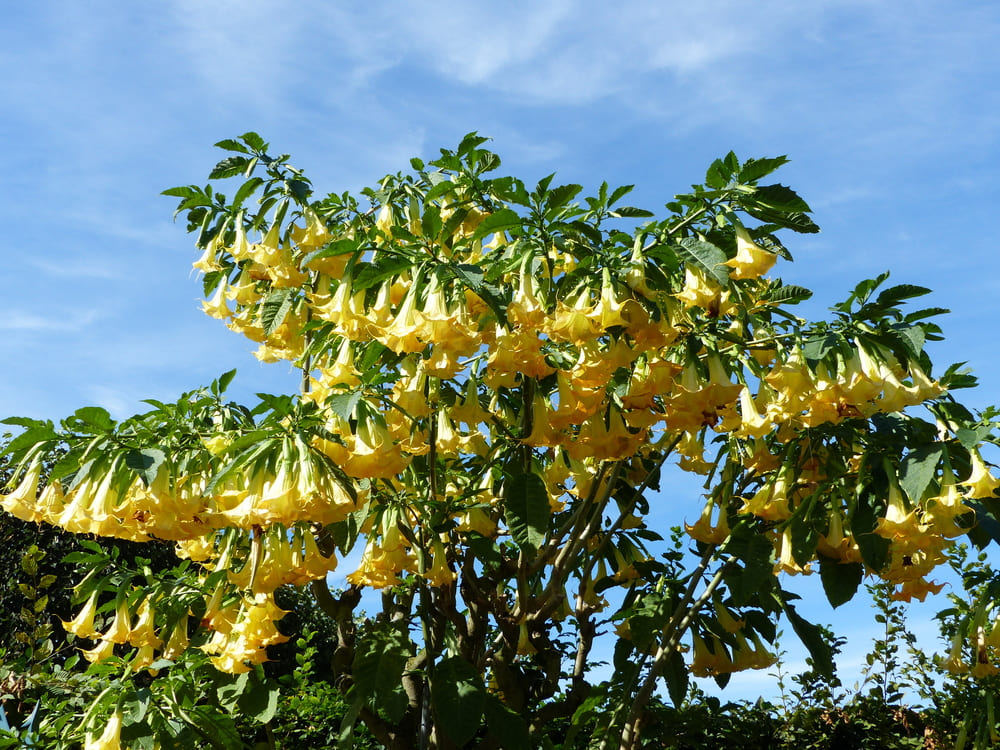
Brugmansia is a beautiful tropical flowering plant. Originally from South America, it is now naturalized in Mexico, Colombia, and several Pacific Ocean islands. The plant grows in full sun and needs regular watering. It also tolerates light frost.
Brugmansia is a small, sturdy tree or shrub. It is an excellent choice for a landscape. It is a heavy feeder, and will need regular fertilization. It is best suited to a well-drained, organic soil. Brugmansia is a good choice for a Mediterranean-style garden.
The leaves of Brugmansia are dark green, oval, or pointed. They are firm and waxy. Their seedpods are egg-shaped. The flowers of Brugmansia are white, tubular, and voluminous. The petals are usually divided into 5 segments. The flowers open overnight, and close again in the afternoon.
There are two varieties of Brugmansia: Brugmansia arborea, with smallest leaves, and Brugmansia x candida, with largest flowers. The latter is a hybrid of two B. x candida, and produces large, pink flowers. The flowers are pollinated by insects.
In cultivation, the species of Brugmansia have been bred to produce a number of cultivars. The earliest varieties were introduced into Europe in the 18th century. Some of these, such as Brugmansia ‘Charles Grimaldi’, are profusely blooming.
61. Colocasia Esculenta

Colocasia Esculenta is a type of root vegetable and ornamental plant native to Southeast Asia. This stately Aroid relative is often found growing in swamps and streams. It can grow in areas with a mild climate as well as areas with a colder climate. It can produce large, green leaves or deep, black leaves. It is a versatile plant that is commonly grown as an ornamental plant, but it can also be used as a food source.
Colocasia grows from tubers beneath the ground. It is an easy plant to grow, but it requires a moist, well-drained soil. This Aroid is also relatively disease-free.
When growing this plant, it’s a good idea to use a drip irrigation system to keep the soil moist. This allows the plant to have time to dry between waterings. It’s a very heavy feeder, so you’ll need to give it half strength fertilizer with a balanced N-P-K ratio.
Colocasia can be cultivated in a wide range of climates, but the plant usually loses leaves in cold temperatures. When the temperature drops below 21 degrees Celsius, the top of the plant will die. This allows the plants to keep a tidy appearance.
When planting, it is important to keep the rhizomes at least five centimeters long. This plant will naturally grow in shade, but it can also grow in bright, indirect light.